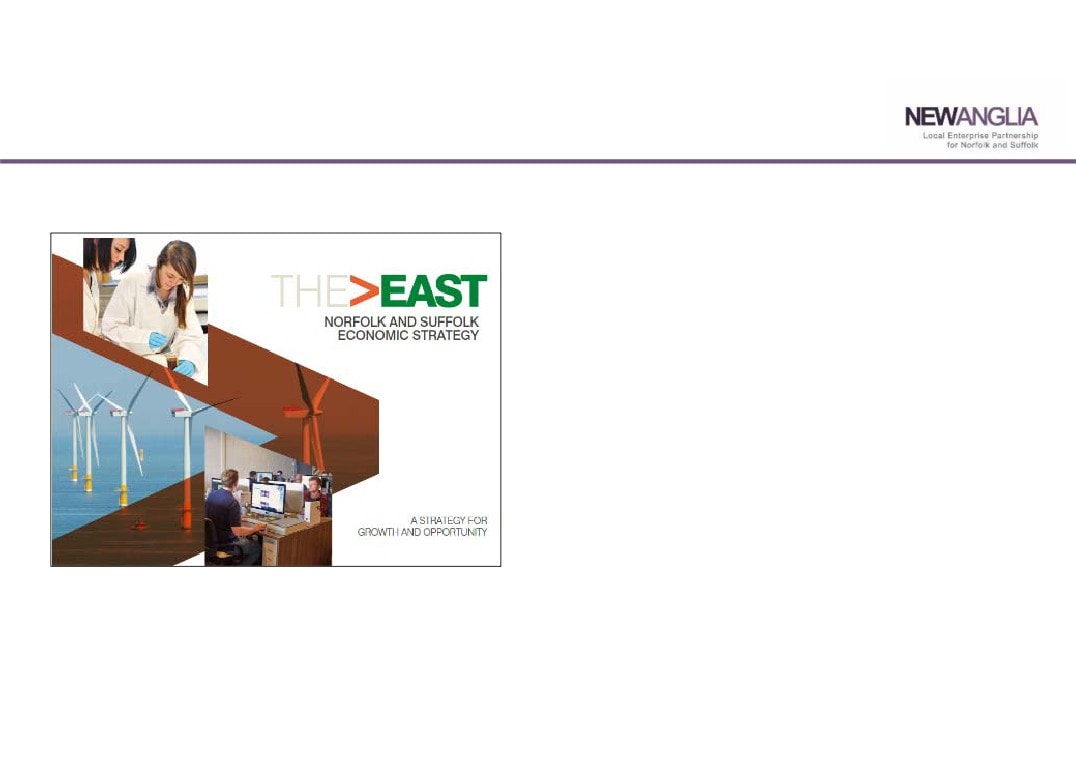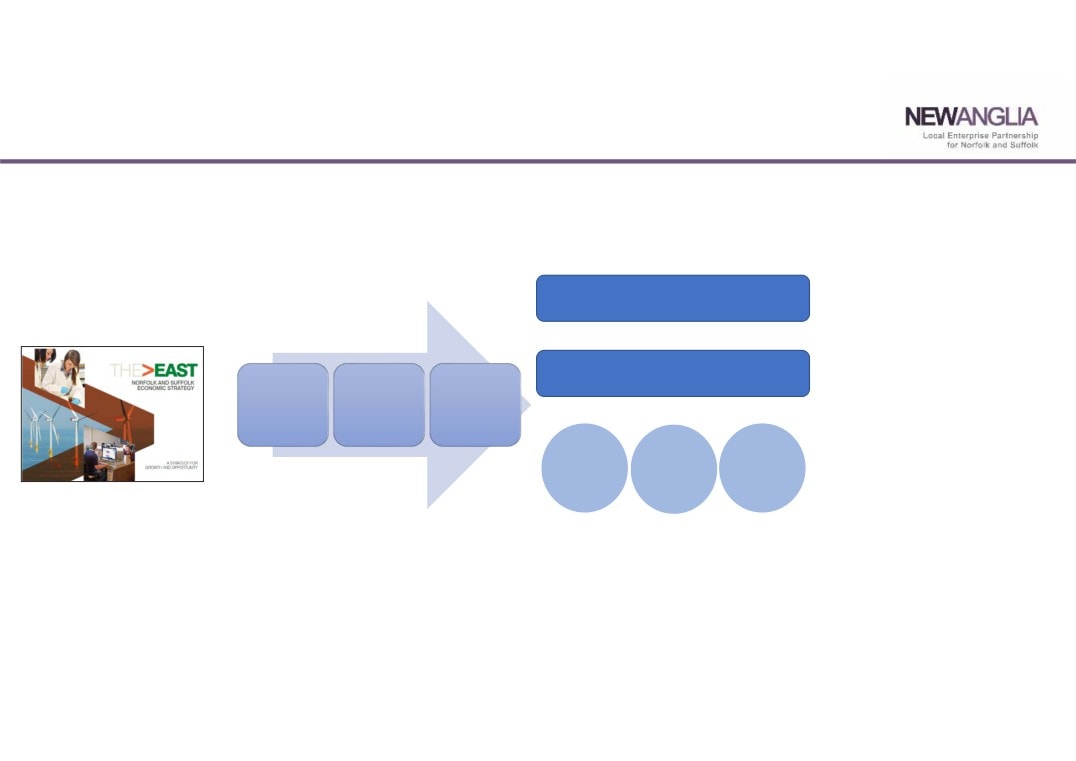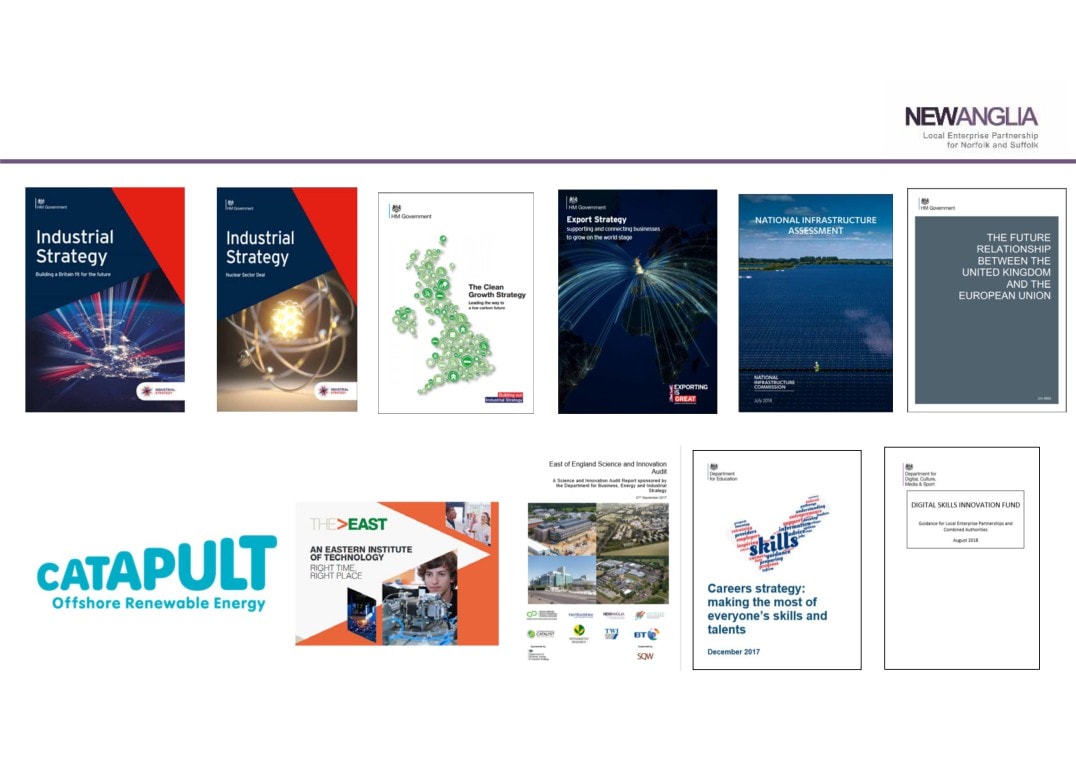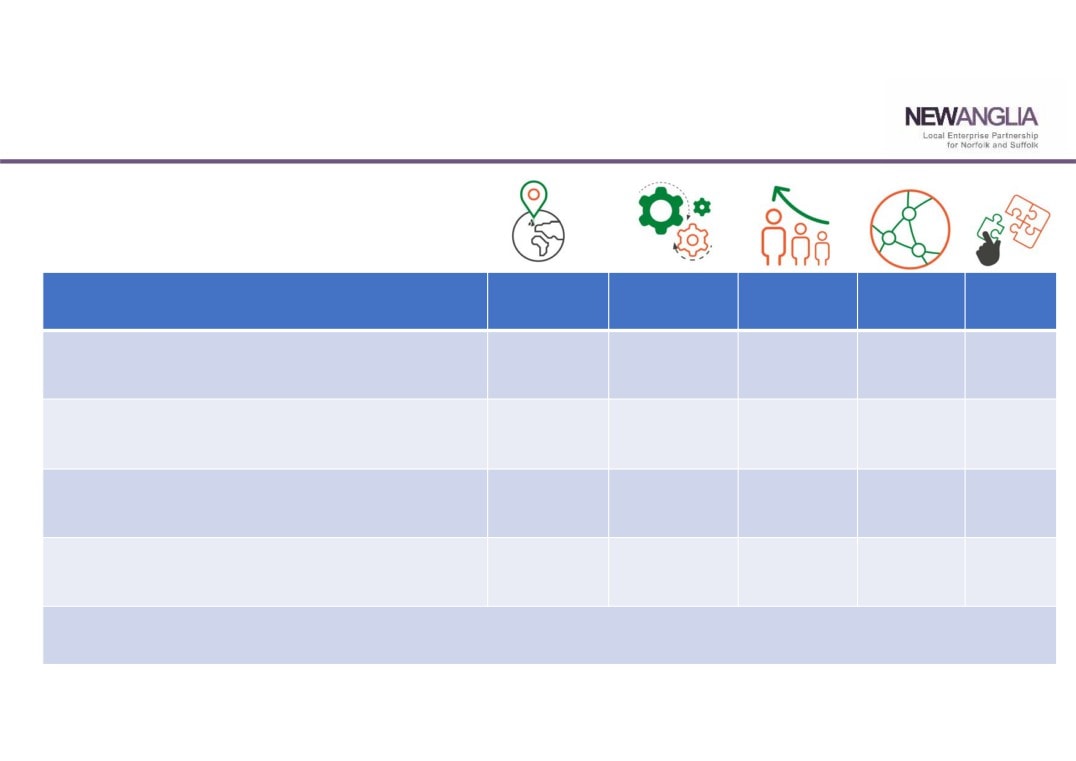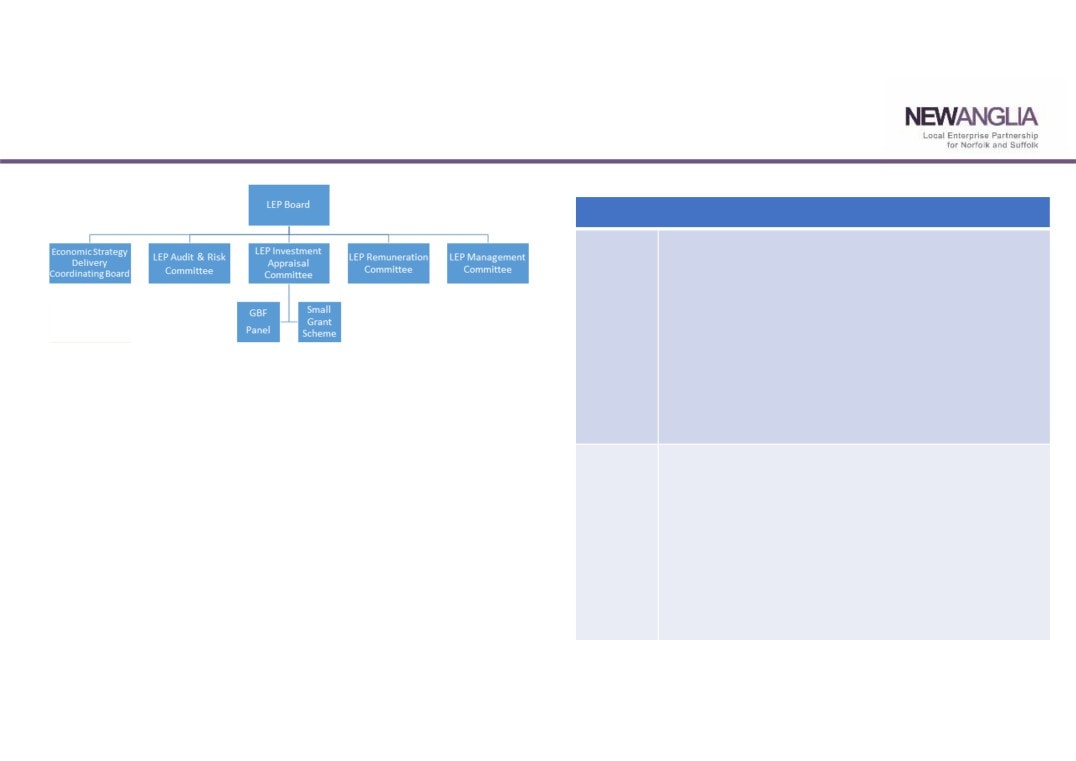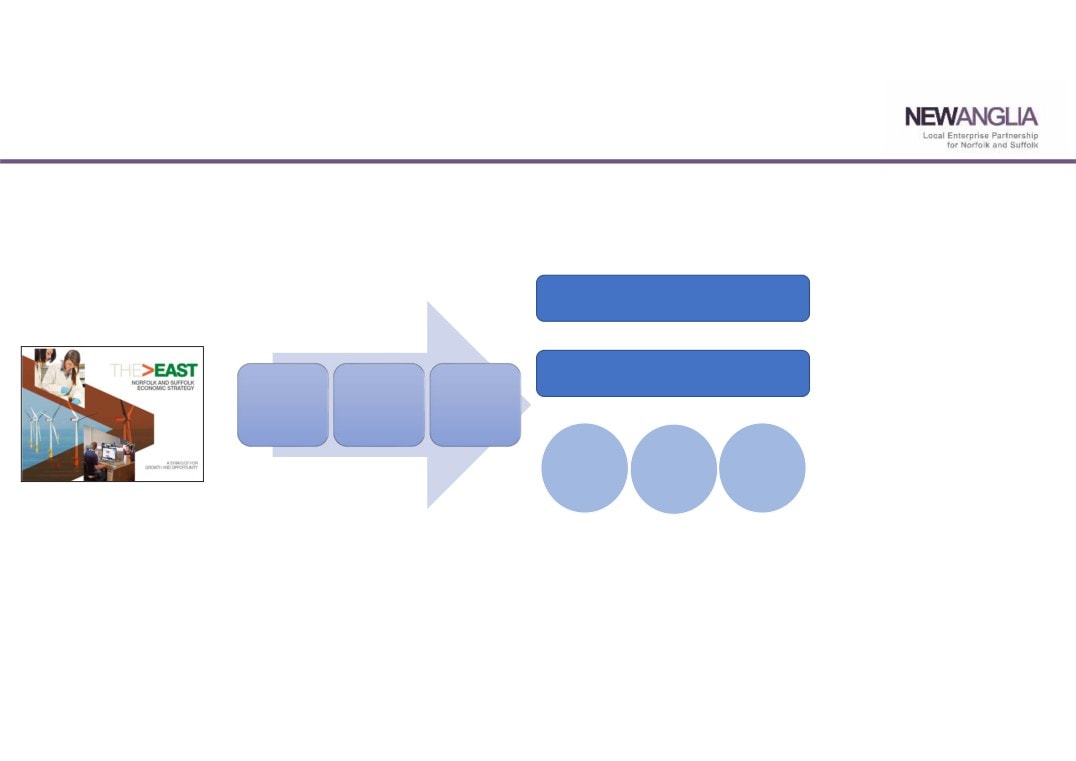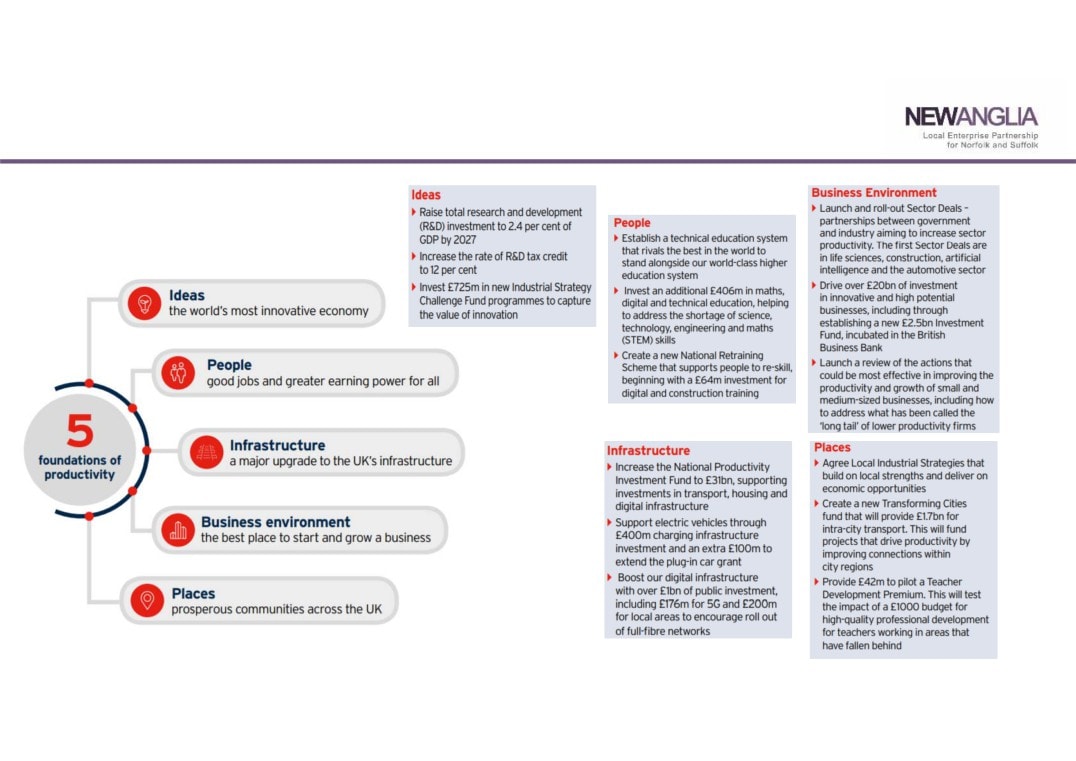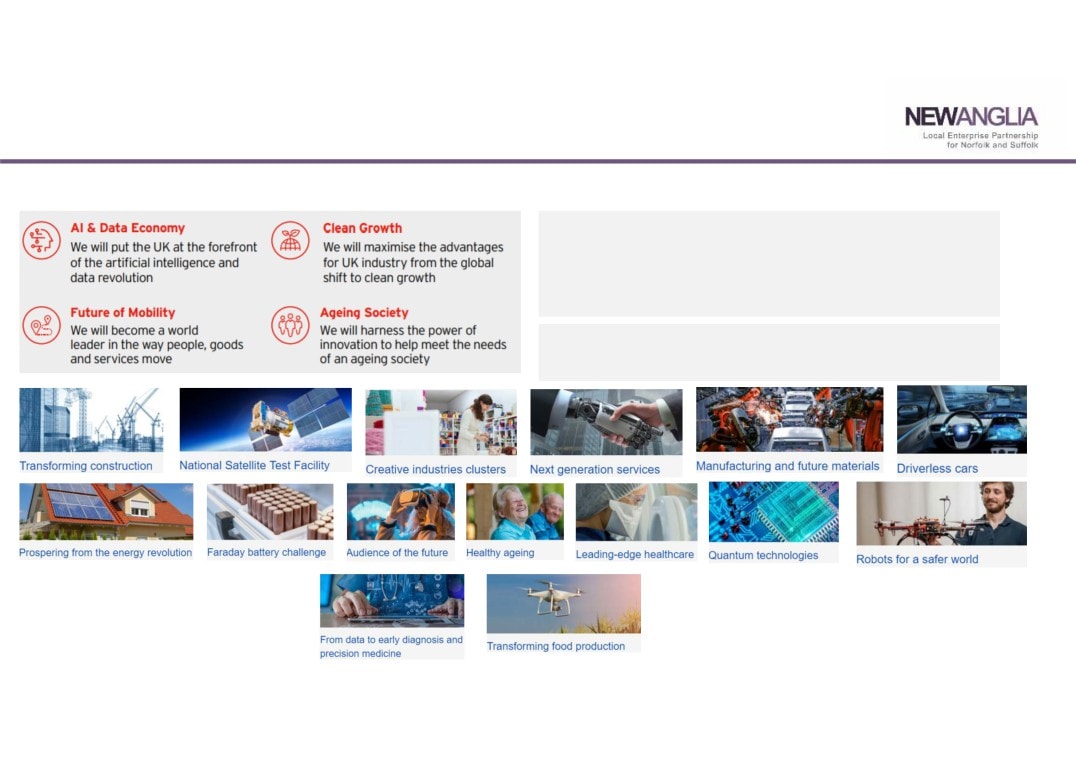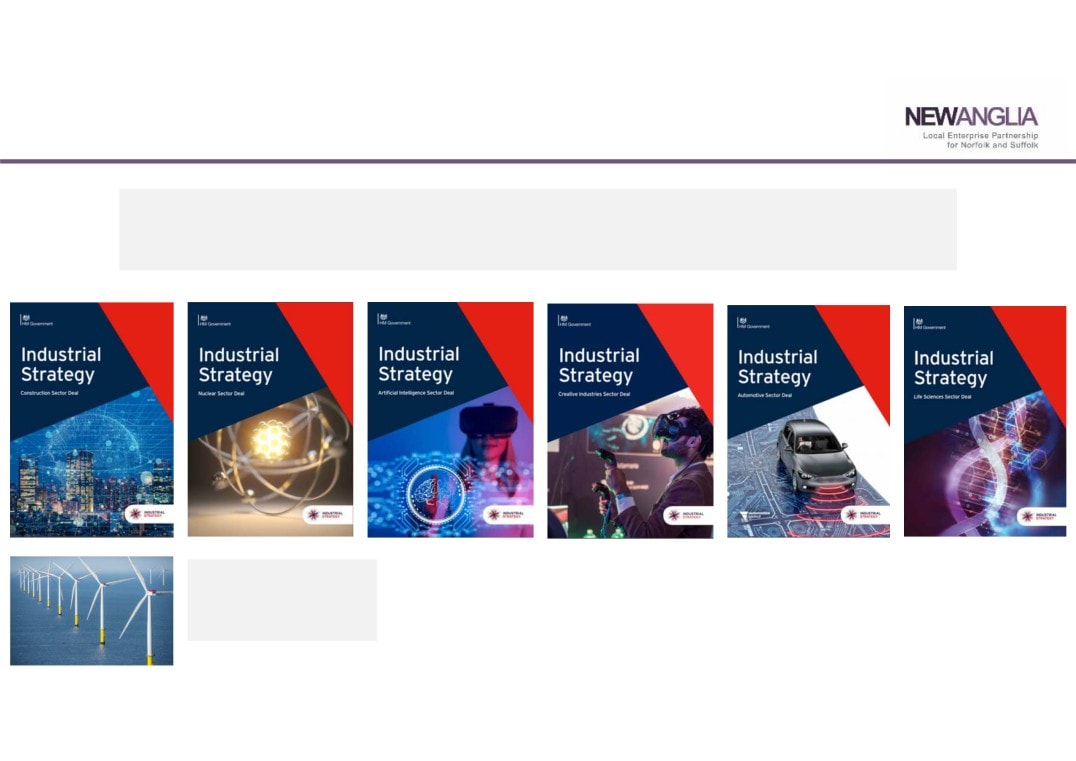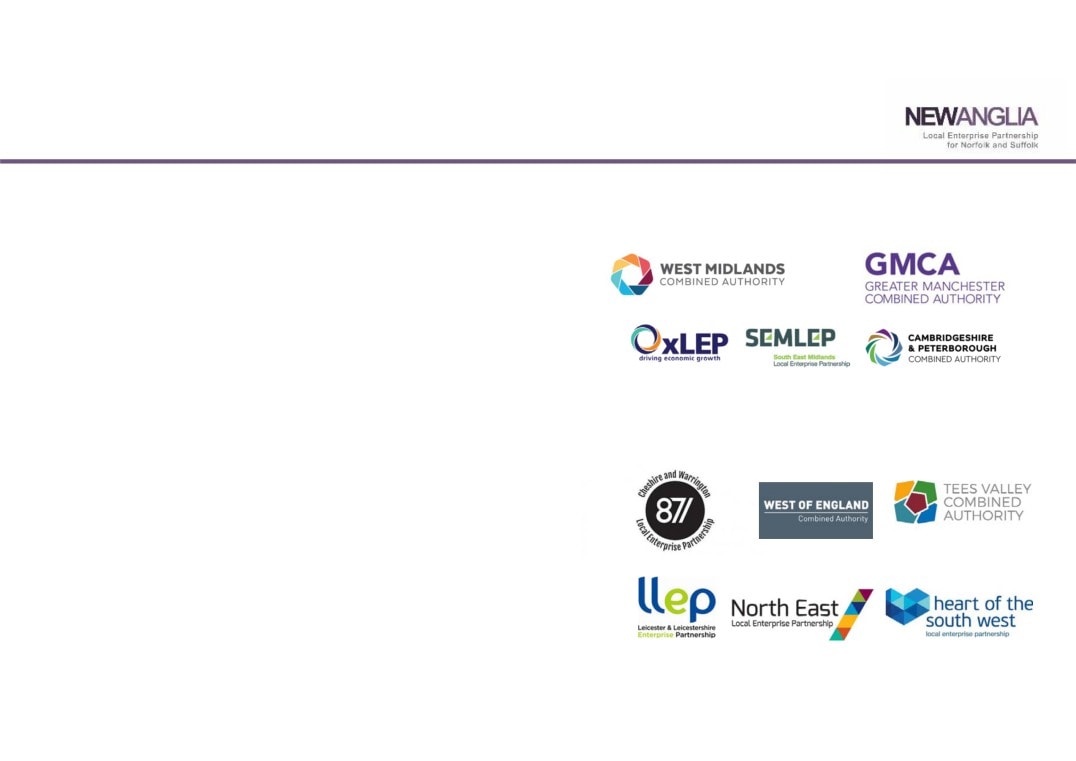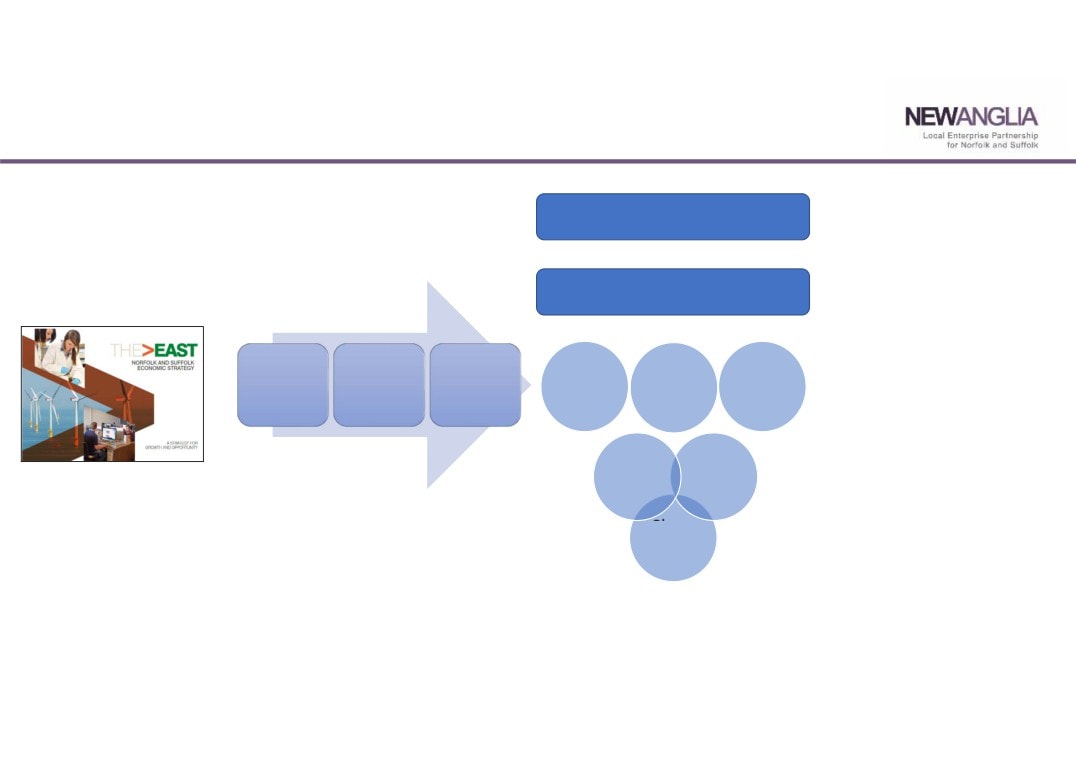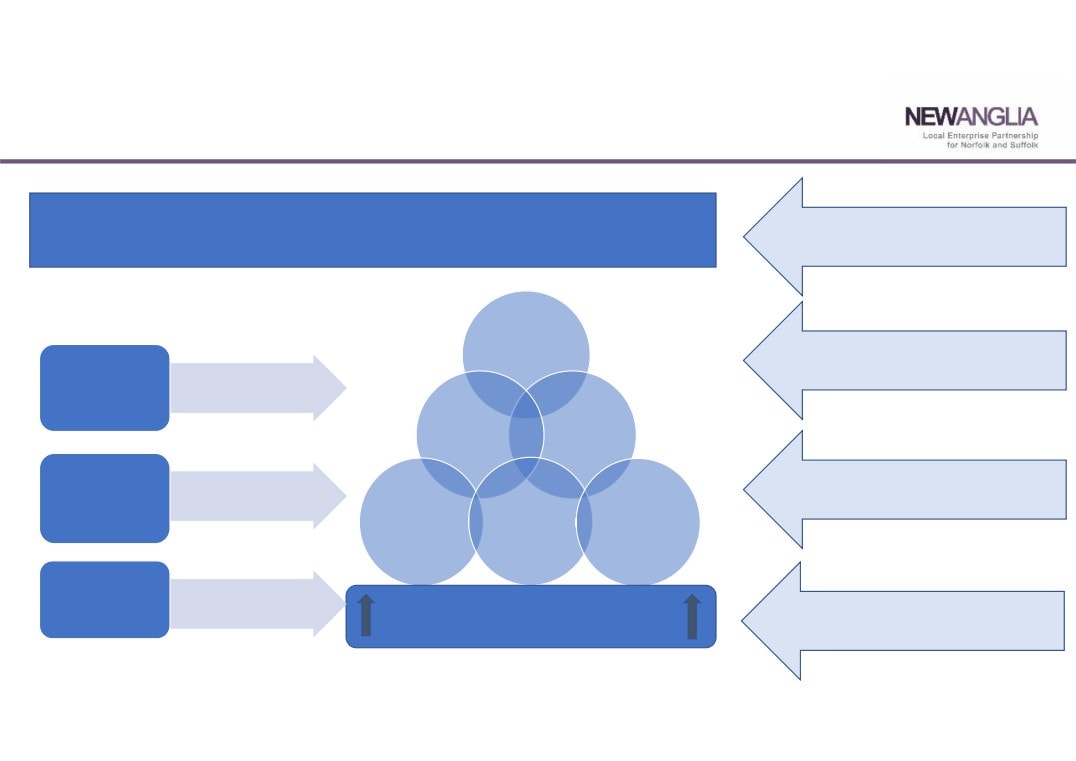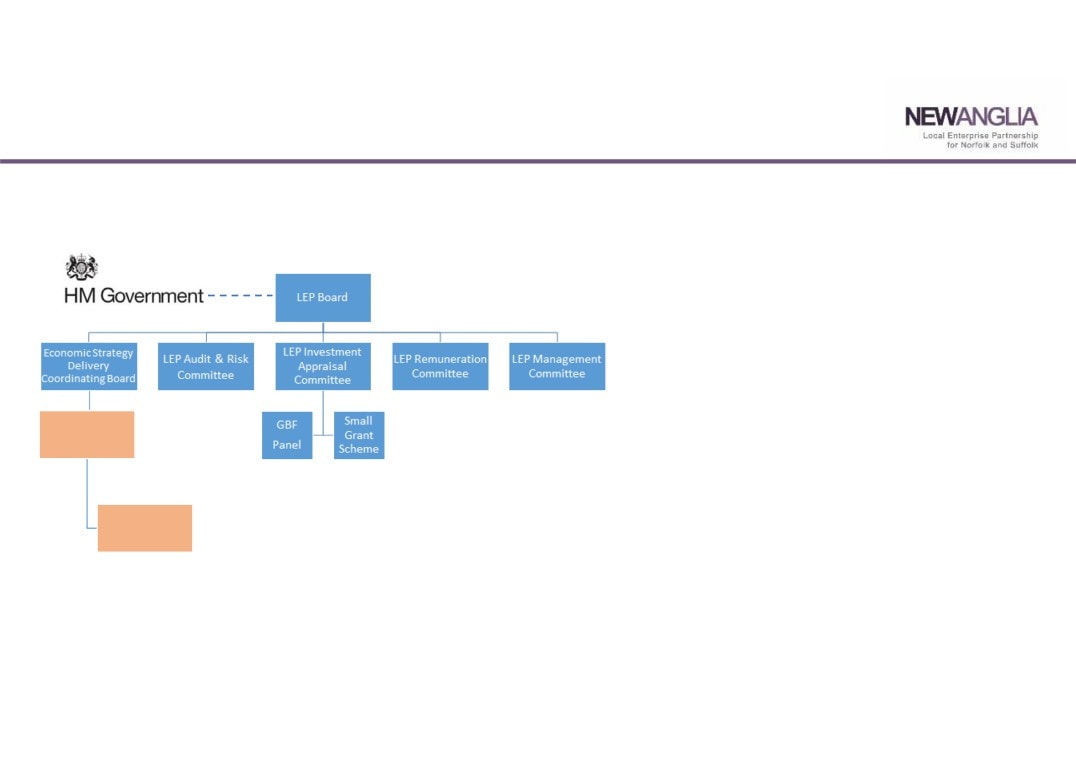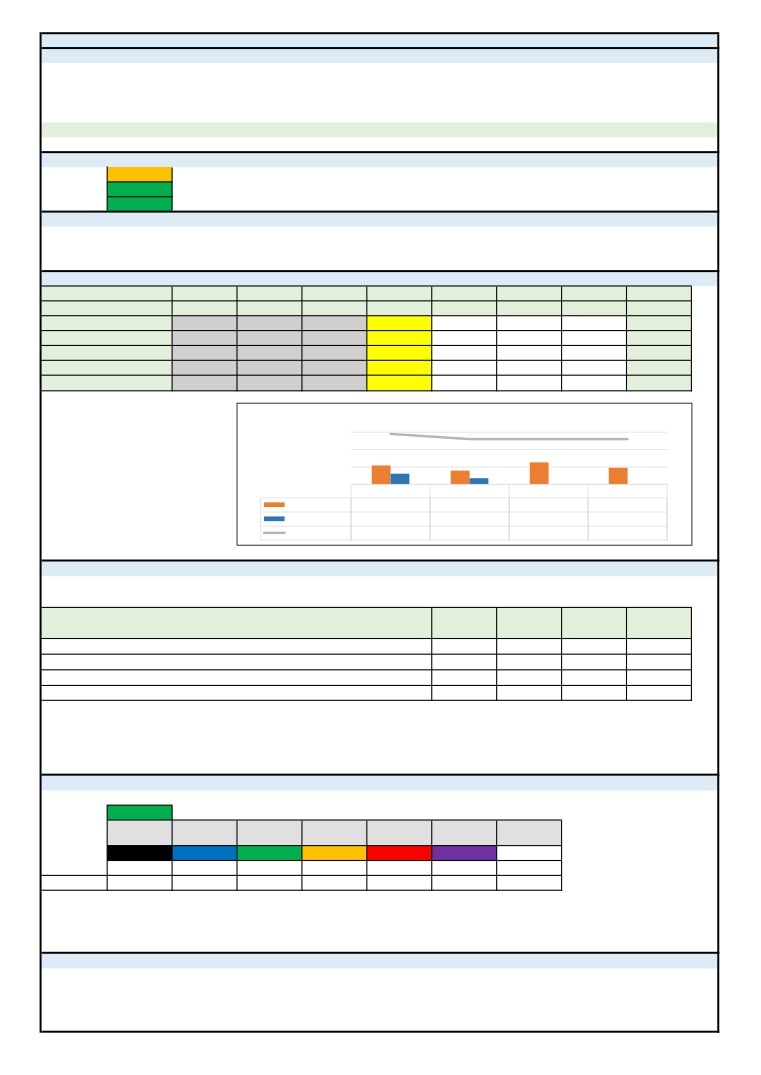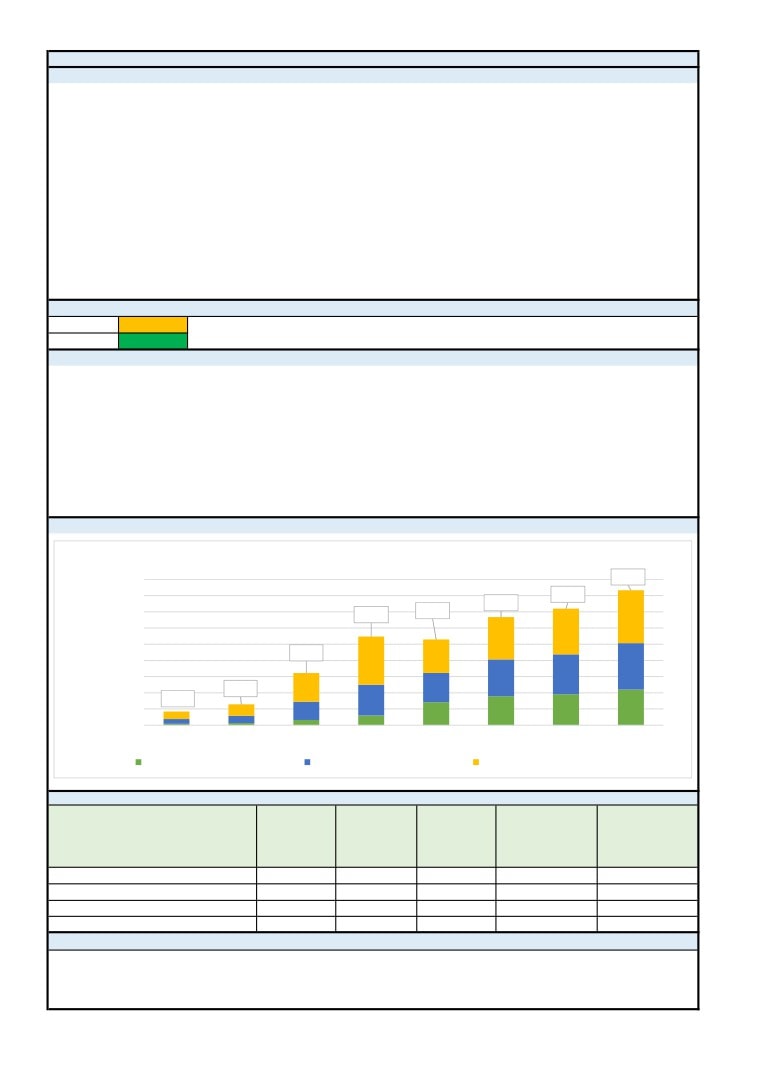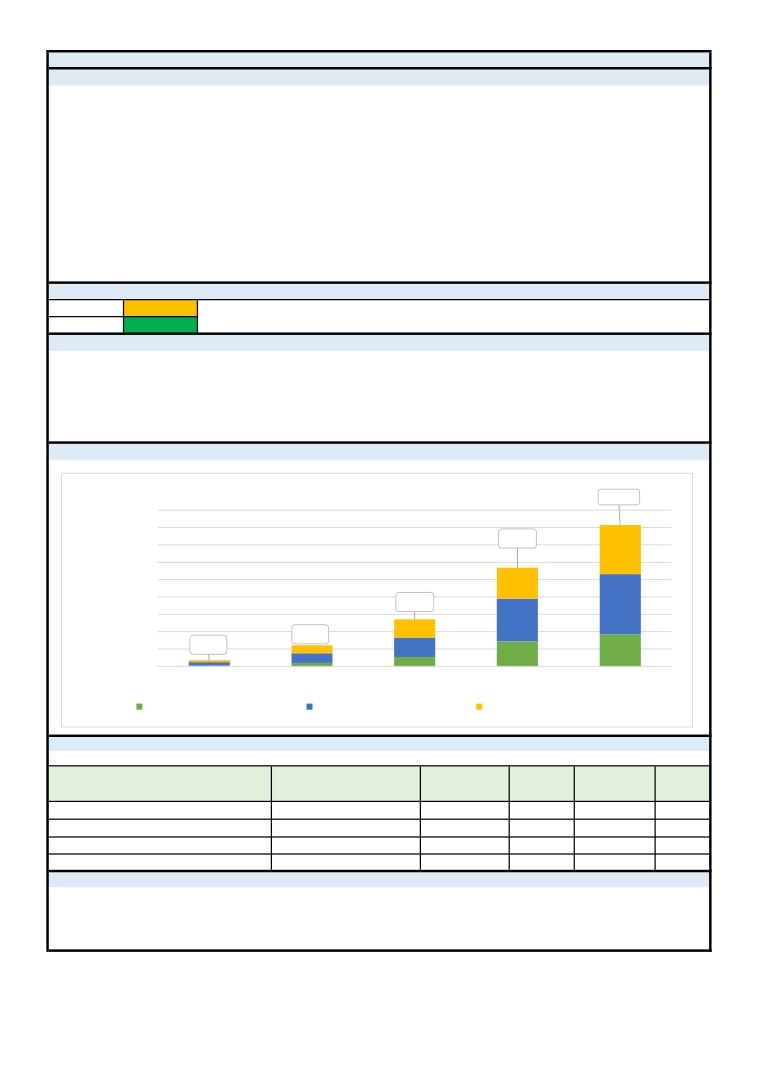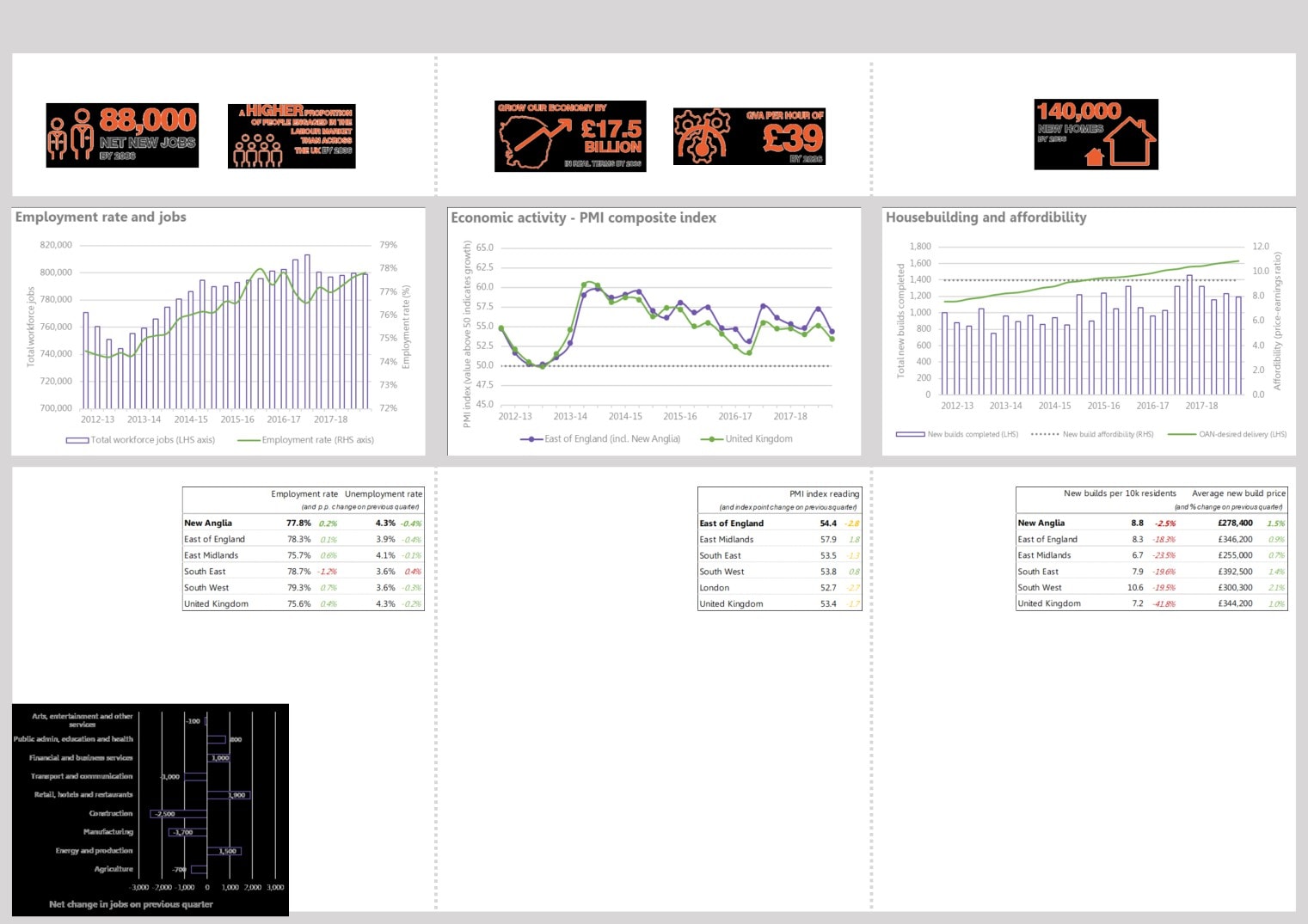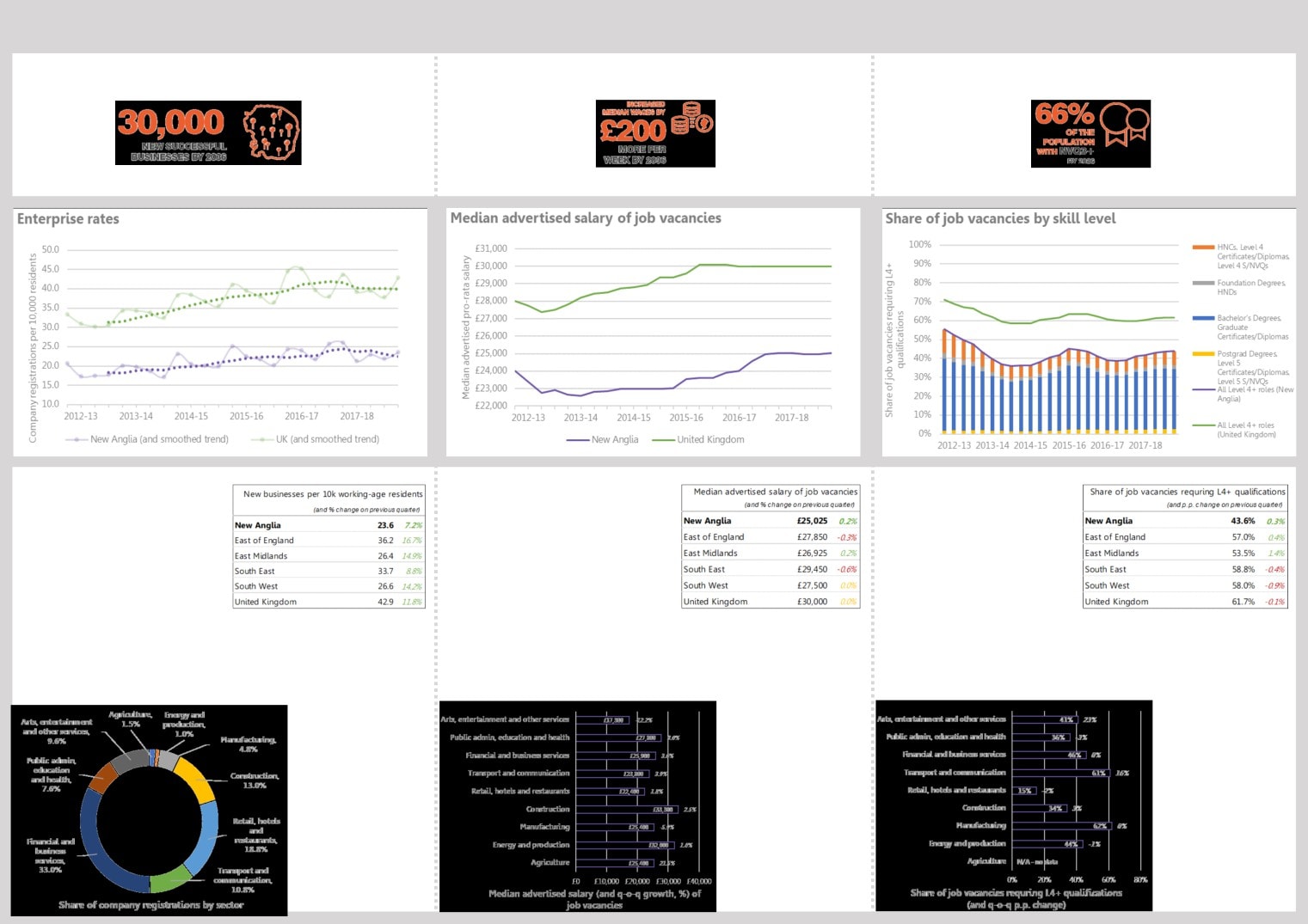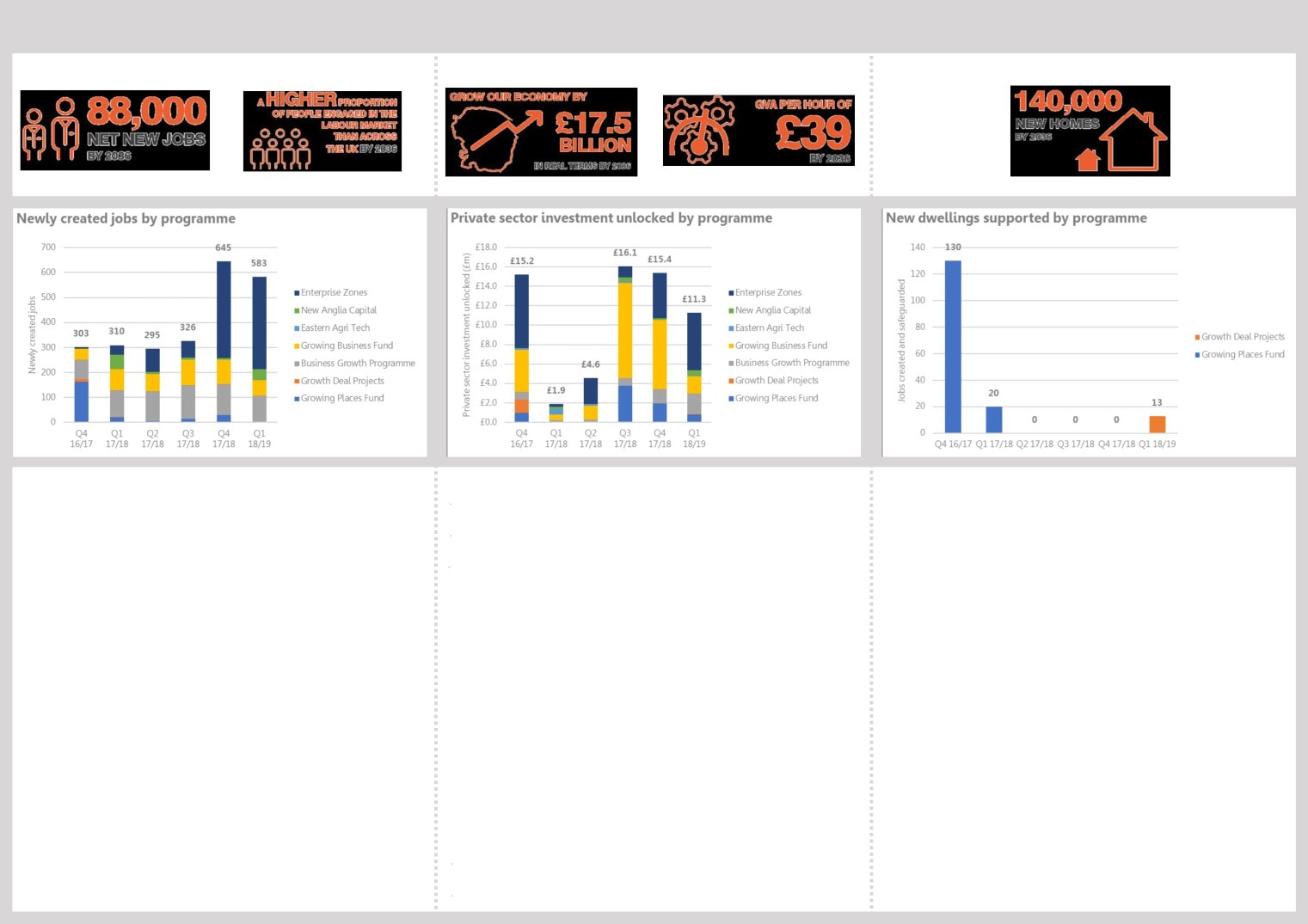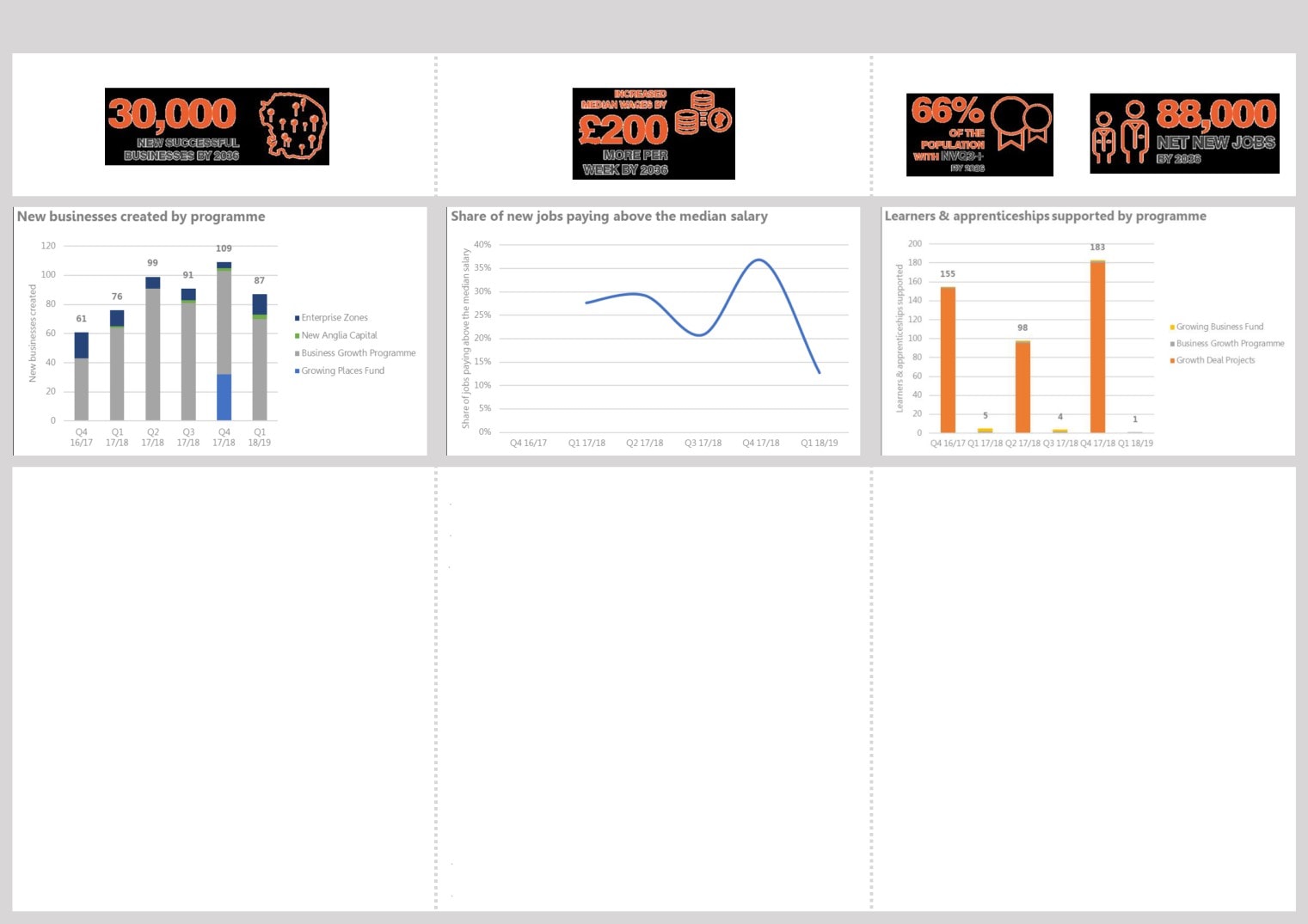New Anglia Local Enterprise Partnership Board Meeting
Wednesday 19th September 2018
10.00am to 12.30pm
The Bleriot Room, The Aviation Academy, Anson Road, Norwich, NR6 6ED
Agenda
No.
Item
Duration
1.
Welcome
20 mins
2.
Apologies
3.
Declarations of Interest
4.
Actions / Minutes from the last meeting
Forward Looking
45 mins
5.
Place Brand Development for Norfolk and Suffolk
Update
6.
Economic Strategy Delivery Plan
For Approval
7.
Local Industrial Strategy
For Approval
Governance and Delivery
15 mins
8.
LEP Review
For Approval
Break
10 mins
Governance and Delivery
60 mins
9.
Chief Executive’s Report
Update
10.
Programme Performance Reporting
For Approval
Update & For
11.
September Programme Performance Reports
Approval
12.
Finance Report including Confidential Appendices
Update
13.
Board Forward Plan
For Approval
14.
Any Other Business
Next Meeting:
10.00am - 12.30pm, 18th October 2018
Venue:
Sizewell B Vistor Centre, Leiston, Suffolk. IP16 4UR
1
New Anglia Board Meeting Minutes (Unconfirmed)
20th June 2018
Present:
Doug Field (DF)
East of England Coop
John Griffiths (JG)
St Edmundsbury Borough Council
Matthew Hicks (MH)
Suffolk County Council
Steve Oliver (SO)
MLM Group
Andrew Proctor (AP)
Norfolk County Council
William Nunn (WN)
Breckland District Council
David Richardson (DR)
UEA
Alan Waters (AW)
Norwich City Council
Jeanette Wheeler (JW)
Birketts
Lindsey Rix (LR)
Aviva
In Attendance:
Corrienne Peasgood (CP)
Norwich City College (For Nikos Savvas)
Warren Ralls (RaW)
LEP Network (Guest)
Vince Muspratt (VM)
Norfolk County Council
Sue Roper (SuR)
Suffolk County Council
Shan Lloyd (SL)
BEIS
Paul Winter (PW)
Skills Board (For Item 9)
Chris Dashper (CD)
New Anglia LEP (For Item 12)
Hayley Mace (HM)
New Anglia LEP (For Item 7)
Julian Munson (JM)
New Anglia LEP (For Item 8)
Lisa Roberts (LiR)
New Anglia LEP (For Item 9)
Chris Starkie (CS)
New Anglia LEP
Helen Wilton (HW)
New Anglia LEP
Rosanne Wijnberg (RW)
New Anglia LEP
1
3
Actions from the meeting: (20.06.18)
None
1
Welcome from the Chair
Doug Field (DF) welcomed everyone to the meeting including Corrienne Peasgood deputising for Nikos
Savvas and Warren Ralls from the LEP Network. DF also welcomed new Board members Matthew Hicks
and William Nunn.
2
Apologies
Apologies were received from: Nikos Savvas, Sandy Ruddock, Dominic Keen, Johnathan Reynolds,
David Ellesmere and Tim Whitley.
3
In Memorium
The meeting held a minute’s silence in memory of Cllr Cliff Jordan who passed away earlier in the month.
4
Declarations of Interest
Item 12: Honingham Thorpe Food Enterprise Park - Jeanette Wheeler
5
Introduction - David Richardson
David Richardson (DR) gave the meeting a presentation on the UEA providing details of the wide range
of activities carried out at the university including environmental studies, clean energy, digital skills and
heath.
DR also provided details on the network partners engaged with the UEA and the ongoing work to bring
together the private and public sectors in development projects.
6
Minutes of the last meeting 23rd May 2018
The minutes were accepted as a true record of the meeting held on 23rd May.
Actions from last meeting updated as follows:
Item 6 Enterprise Zones
To receive further information on the make up of jobs on EZs and the rationale for companies
JM
moving into the zones. Work is ongoing and will be presented back at the September Board
7
Place Branding
Hayley Mace (HM) presented the paper on Place Branding which outlined plans for further
development of a single place brand for Norfolk and Suffolk (currently branded as The East).
HM proposed tendering for a branding agency to progress the work to develop the brand
messages, the visual identity and to carry out testing of the Brand as it is developed. The Board
was asked to agree funding of £50,000 for the first stage of brand development and also to agree
the timeline of activity.
The Board was asked to note proposals for the second stage of work, which included the creation
and implementation of a set of marketing tools likely to include an online portal. The second stage
of work will be funded, in part, by the successful ERDF Invest East bid.
Chris Starkie (CS) noted that this will not replace any established brand but will complement
existing more local or sectoral brands.
The meeting discussed the importance of having an overarching brand but noted that it was
important to have a clear picture of existing brands so that their clarity and positioning was not
diluted
Steve Oliver (SO) stressed that the current picture of multiple brands was not sufficiently clear
but these would be brought together under one brand with a clear communications strategy.
Jeanette Wheeler (JW) noted there were other similar brands across the country which sat
above other sub-brands without confusion.
HM confirmed that she had researched the costs from agencies and other similar work already
carried out nationally and by other LEPS and that the £50k requested was competitive.
2
4
Matthew Hicks (MH) asked for more detail on the costs of the 2nd stage of the work.
Julian Munson (JM) advised that the ERDF funded Invest East project would include funding
for this work and £148,000 would be allocated to the second phase which included marketing
and events.
Alan Waters (AW) asked whether there would be any review points included along the process.
HM confirmed that this could be built into the tender brief.
The Board agreed:
To note the content of the report
To agree funding of £50,000 for the first stage of brand development
To agree the timeline of activity.
8
Inward Investment
JM provided the Board with a presentation on the Inward Investment Strategy.
It was highlighted that the strategy did not just cover investment from overseas but also
domestic companies investing in the region, the expansion of existing companies and also the
retention of businesses already operating in the region.
JM described the progress made since the last Board paper in 2017, ongoing work and details
of overseas investment in eastern counties over the past year.
JM also reviewed the proposed delivery model stressing that the strategy needed to include the
varied offers available from the region including systems, services, science and technology and
skills and talent. Board members were updated on current work aimed at building international
relations across the world including that centred on the Guangdong province in China.
The meeting was advised that the £1.8m ERDF Invest East project would be starting in
September 2018. This will focus on how investment leads are drawn into the local area and
providing specific support enabling a business to develop its investment proposal.
The meeting discussed the importance of producing a strategy under a single brand. AP noted
that the joint working with partners needed to be highlighted within the strategy and CS
confirmed that it was based on a collaborative approach.
DR noted the importance of making the right first impression when establishing links with
Guandong and that many businesses already have such links with the province and these
could be built on and steered by the LEP.
The Board agreed:
To endorse the approach and development of the Inward Investment and International
Strategic Framework set out in the paper
To support the launch and activity of the Invest East ERDF business support / inward
investment project
To approve the investigation of a suitable inward investment agency delivery model
To consult with the county councils on a pilot project to advance relations with Guangdong
province in China
9
Skills
Paul Winter (PW) presented the Board with an update on the work of the Skills Board over the
past year and the challenges faced by the region in relation to skills.
He reviewed the Skills Board vision and delivery steps which form part of the Economic Strategy
Delivery Plan and reiterated the four ‘key messages’ of the Skills Board which Board members
were requested to support and champion.
The importance of lobbying Government was stressed and DF confirmed that this issue had
been raised at the LEP Network meeting with the Prime Minister.
The Board agreed:
To note the content of the report
3
5
To endorse the Skills Board vision and delivery steps
To champion the ‘key messages’ of the Skills Board.
10
Enterprise Adviser Network
CS presented the paper on the Enterprise Adviser Network (EAN) highlighting the bid to host a
careers hub, the progress made by the EAN and the recommendation to bring the programme
within the LEP.
Board members were advised that the EAN has encountered challenges in recruiting enterprise
advisers, the churn of staff within schools and commitment from schools following the initial
expression of interest.
Corrienne Peasgood (CP) asked whether there was any link between those schools who have
not engaged and those who have received initiatives and funding from elsewhere. CS felt that
the biggest influence on engagement was the approach of the Headteachers as not all saw the
benefit of engagement with the EAN.
MH noted that there were many similar schemes which could make the options for schools
confusing. CS replied that this approach was designed to clarify this for schools.
The Board agreed:
To approve further 12 months funding for the EAN at a value of £135,000
To endorse the development of the Careers Hub and the integration of its management
with the EAN
11
Local Energy Strategy
Lisa Roberts (LiR) presented the paper on the Local Energy Strategy to the Board.
The Board was advised that responses have been requested by 6th July however the deadline
will be extended to allow local Authorities to complete their endorsement processes.
90 applications have been received for the role of Regional Hub Manager with New Anglia LEP
being part of the interview panel.
The Board agreed:
To endorse the Local Energy Strategy
To agree the next steps regarding the Strategy’s Delivery Plan
12
Capital Growth Programme - Honingham Thorpe Food Enterprise Park - Confidential
The Board agreed:
For the executive team to develop a supplementary paper for the IAC to review
For the recommendation from the IAC to then be considered by the full board by written
procedures
13
Revenues Funding Framework
CS presented the paper produced on the proposed revenue funding framework for Pot C
income.
SO asked whether there were established Governance criteria for the call for innovative
projects from external partners.
CS advised that these would be included in the framework which would be developed before
being presented to the IAC.
The Board agreed:
To approve the allocation of £135,000 set aside in Pot C for core LEP costs to fund the
Enterprise Adviser Network for 18/19
To approve the allocation of £100,000 from Pot C towards the LEP projects budget for
18/19
To approve the allocation of £500,000 from Pot C towards the call for innovative projects
from external partners which will help deliver the Economic Strategy
4
6
14
Growth Deal Quarterly Dashboard
CD reviewed the paper and the quarterly dashboard for submission to Government.
AW asked whether a further breakdown of the details of the jobs created was available.
CD confirmed that they were all FTEs but further work would be required to ascertain the
quality of jobs provided.
CS advised that this dashboard was as set out as per Government requirements however this
detail would be built into the ongoing development of BPRs which would be presented after the
summer.
SO queried the delivery of housing which appeared to be behind target. CD confirmed that
outputs were delivered on an ad hoc basis as developments were completed and so figures
would increase on completion.
The Board agreed:
To endorse the dashboard
15
Chief Executive’s Report
CS asked the Board for any questions on his report.
DF updated the meeting on the meeting of LEP Chairs with the Prime Minister on 19th June
where the PM had expressed support for the work of LEPs across the country. DF thanked
Warren Ralls for organising the event.
The Board agreed:
To note the content of the report
16
Finance Report
Rosanne Wijnberg (RW) reviewed the finance report and asked for questions from the Board.
As the July LEP Board has been cancelled it was proposed that the Annual Accounts would be
issued electronically for approval by email in July.
The Board agreed:
To note the content of the report
To receive the Annual Statements via email for approval following the recommendation
of the Audit and Risk Committee.
17
Board Forward Plan
CS reviewed the items to be covered at the September Board.
The Board agreed:
To note the content of the plan
18
Any Other Business
John Griffiths (JG) asked whether substitutes can attend the IAC as well as the Board.
Next meeting:
Date and time of next meeting:
10.00am - 12.30pm, 19th September 2018
Venue: The Aviation Academy, Norwich
5
7
Actions from New Anglia LEP Board Meetings
Date
Item
Action
Update
Actioned By
Status
23/05/2018
Enterprise Zones
To receive further information on the make up of jobs on EZs and the rationale
See update paper following the Action Log
JM
Complete
for companies moving into the zones.
21/02/2018
Economic Indicator
To receive a paper on CO2 reductions for
Work is ongoing in conjunction with the UEA
CS/JR
On-Going
Trajectories and Targets:
consideration of inclusion in the economic strategy targets
21/02/2018
Brexit Analysis
To receive an action plan detailing the next steps, timescales and measures of
Analysis is ongoing and will be incorproated into
LiR
On-Going
success
the Local Industrial Strategy
22/11/2017
Business Performance
To receive a proposal on the Eastern Agi-Tech initiative by email.
CS has been in communication with the Combined
CS
On-Going
Reports
Authority and a paper will go to a future Combined
Authority Board meeting
8
Board Actions Update
23/05/2018: NALEP Board Action: “To receive further information on the make up of
jobs on the EZs and the rationale for companies moving into the zones”
Response from New Anglia LEP Enterprise Zone Team:
The vast majority of companies moving onto our Enterprise Zone sites are doing it for
reasons of expansion. This shows up as net jobs on our monitoring returns. Furthermore a
number of the District Councils (Collection Authorities) operating the rate grant rebate have a
displacement check on their processes that avoids this possible distortion.
It should be noted that the full expansion might not be immediate as companies are
sometimes taking on larger premises with a view to employing more staff in the future as
they gain new contracts/work.
A few firms also move into larger premises on the zones because they provide modern
premises to allow them to operate in a more productive way. The rate grant incentive of
course ends in March 2021 (for Space to Innovate EZ) and in reality, is modest in relation to
the costs of moving premises.
The average rate grant award is below £25k per annum and even for five years this is only a
modest contribution to company operating costs. There have been a limited number of
occasions where a company move is driven by consolidation rather than growth. In these
circumstances the prism by which it is examined is the risk of jobs being lost to the New
Anglia area i.e. job retention.
An analysis has been carried out for the Great Yarmouth and Lowestoft Enterprise Zone as
the data is a better quantifiable base of data to monitor increase and decreases in
companies as the zone has been in place for a number of years (the Space to Innovate EZ
has only been in situ for 2 ½ years).
After analysing the Great Yarmouth & Lowestoft monitoring data, as collected over the past
7-year period, of those businesses that have expanded they have, on average, taken on
30% more staff since they moved an Enterprise Zone site.
We have had only one business (out of 52) which has decreased its staffing from 65 to 23.
This is entirely related to the downturn in the oil and gas sector, but the company have
remained afloat without any public sector assistance and are still pivotal in the energy sector
in the coastal region.
9
New Anglia Local Enterprise Partnership Board
Wednesday 19th September 2018
Agenda Item 5
Place Brand Development for Norfolk and Suffolk : Agency introduction
Author: Hayley Mace and Julian Munson Presenter: Steve Oliver
Summary
This paper outlines an introduction to the agency selected to carry out the place brand
development work for Norfolk and Suffolk.
Background
In June 2018, the Board agreed funding for the first stage of place brand development. A tender
was issued following the Board meeting and 20 submissions were received, with high quality
entries from agencies across the UK.
The submissions were reviewed and scored by Hayley Mace, Julian Munson and the three
members of the Board steering group for the project - Steve Oliver, Jeanette Wheeler and Sandy
Ruddock. Six agencies were invited for interview, with Steve Oliver, Sandy Ruddock, Julian and
Munson and Hayley Mace sitting on the panel.
A joint submission from Ipswich-based CMS and Jacob Bailey was selected by the interview
panel. They have placemaking and branding experience, working with a number of towns, cities
and Business Improvement Districts across the UK. As part of the Savills group, CMS can offer
access to input and testing on international investors which will be of significant benefit to this
project.
An inception meeting was held on 30th August to discuss plans for stakeholder engagement
sessions, which will take place over the coming months.
Neil Prentice (Jacob Bailey) and Fiona Wright (CMS) will give a brief introduction to their proposal
and timeline at the September Board meeting. It is envisaged that work will be completed by the
end of January 2019, with the final project findings to be brought back to the LEP Board in
February 2019.
1
15
New Anglia Local Enterprise Partnership Board
Wednesday 19th September 2018
Agenda Item 6
Economic Strategy Delivery
Author: Lisa Roberts Presenter: Lisa Roberts
Summary
This paper provides an update on the Economic Strategy delivery plan and sets out the
proposed concept of game changers which would boost delivery and deliver material impact on
the Economic Strategy Ambitions. Appendix A which accompanies the report is a more detailed
presentation which will be delivered at the board meeting.
Recommendation
The Board is asked to:
Note the progress the development of the Economic Strategy delivery plan for the
Economic Strategy;
Agree the concept of developing game changers.
Background
Since the Economic Strategy was published in Autumn 2017 work has been underway to
develop delivery plans. There have been three stages to development - mapping existing
activity, identifying gaps and identifications of innovative solutions.
All three stages have involved engagement with a wide range of partners including businesses,
business intermediary groups, Local Authorities, education providers and the Voluntary and
Community Sector to help shape delivery (see pages 5 & 6 of appendix A).
We have continued to enhance and evolve the evidence base which has helped to shape and
support interventions. The publication of a range of national and local strategies and plans has
also been considered.
The Economic Strategy Delivery Coordinating Board (ESDCB) has been established meeting
for the first time on 4th September (see page 12 appendix A).
Delivering the Economic Strategy
Delivery of the Economic Strategy started the day it was signed off with several existing
projects and interventions already contributing to the delivery of the strategy. As highlighted in
the Strategy it is not being delivered by one partner alone or by one strand of investment.
There are two levels of delivery - local and strategic.
1
17
Local - The ambitions and priorities that were agreed in the Strategy provide the
direction and strategic case for a wide range of partners to develop their own plans and
interventions that contribute to achieving our shared ambitions. Several local partners
have reviewed their own strategies and plans to align with the Economic Strategy,
shaping the right approach to delivery locally - in ‘Places’.
Strategic - Our priority themes are those economic-wide opportunities where the
evidence shows that investment and collaborative action will have the greatest impact
on our ambitions. A strategic delivery plan has been developed using the Objectives
Key Results approach (see page 9 Appendix A) . The plan links directly to the objectives
set out under each of the themes detailing the collaborative activities and interventions
which will deliver them. It is a living document which will evolve over time.
The ESDCB will be responsible for driving and coordinating the delivery of the strategic
plan, discussing delivery plan gaps and identifying innovative solutions to deliver the
objectives. Members of the board will also act as champions for the strategy and liaise
with local plans and places to facilitate join up.
Game Changers Concept
There are three game changer opportunities that have emerged through the engagement
session and the evidence (page 11 appendix A). These are opportunities where focused
collaborative action and prioritisation would have the potential to turbo boost delivery, providing
a significant shift towards the strategic objectives and delivery material impact on our ambitions
and economic indicators.
At the heart of each opportunity there is a key initiative or project that will act as a catalyst and
create wider impact.
This paper is seeking agreement from the LEP Board to agree to proceed with the Game
Changer concept. The Economic Strategy Delivery Board will review the evidence behind the
emerging opportunities and develop delivery plans for each.
Next Steps and Key Dates
26th September - ongoing
The Economic Strategy Delivery Board - Review the strategic
delivery plan and identify solutions for gaps. Consider game
changer opportunities and develop delivery plans.
November - January
Light touch review of Economic Strategy Evidence Base
Late February
LEP Board, LA Leaders and Sector Charis - Economic Strategy
annual progress review.
Recommendation
The Board is asked to:
Note the progress the development of the Economic Strategy delivery plan for the
Economic Strategy;
Agree the concept of developing game changers.
Appendices
Appendix A - Economic Strategy Delivery
2
18
Item 6.1 Appendix A - Economic Strategy Delivery
1
19
Delivering Norfolk & Suffolk Economic Strategy
• Published Autumn 2017
• Looks ahead to 2036 but focuses on action we need
to take over next three years to help secure long
term success.
• A dynamic and living blueprint to guide the work and
investment of many partners.
• A shared endeavour between private, public,
education and Voluntary and Community Sector
(VCS).
• Underpinned by robust evidence base and
extensive engagement and consultation.
• Sets out agreed ambitions and targets.
• Inclusive growth and productivity is a golden thread.
2
20
Economic Strategy Delivery - The Journey So Far…
Local partners have reviewed own
Alignment of local strategies &
strategies and plans to align with
Economic Strategy
plans
Published Autumn 2017
Strategic plan developed using the
Objective Key Results approach. A
Engagement with
Strategic Delivery Plan
Review of National
living plan which outlines the high level
Evidence & Data
over 350
and Local Policy to
Analysis to help
stakeholders
objectives for each of the five themes
help identify
identify
mapping out existing
opportunities and
and the planed activity has been
interventions.
activity & developing
alignment.
innovative ideas
developed.
Building the
Integrated
Innovation
Game Changer approach which will
workforce of
Investment
Ecosystem
turbo change delivery.
the future
& Trade
3
21
Economic Strategy Delivery - The Journey So Far…
Building the
Integrated
Innovation
workforce of
Investment &
• Strategic delivery plan developed in consultation
Ecosystem
the future
Trade
with partners to identify existing and new activity.
•
10 events, 350 individuals from across business,
• Three Game changing opportunities identified
education, VCS and LAs.
through engagement session and links to evidence.
Seeking support on concept.
• A living plan which will evolve over time.
What are ‘game changing’ opportunities….
• Economic Strategy Delivery Co-ordinating Board
established who will drive and coordinate the
….an opportunity that effects a significant shift towards
delivery of the strategic plan. Ensuring all partners
the strategic objectives….
play a part in delivering the ambitions and targets.
….and delivers material impact on the
• Next steps to identify new and innovative
ambitions/economic indicator
interventions to address the gaps in the plan.
At the heart of each there is a key initiative or project
4
that will act as a catalyst and create wider impact
22
Economic Strategy Delivery- Journey so far
Event
Aim
What we did
Outputs
Business
To identify activities which will
Focusing on 3 themes:
Examples included the need to
engagement
drive delivery of the Economic
Our Offer to the World
leverage the Norwich Research Park
sessions
Strategy.
Driving Business Growth
as a local asset; exploring the local
and Productivity
appetite for a Stowmarket tech hub;
Driving Inclusion and Skills
developing a one-stop-shop for
These were interactive
business advice taking lessons from
sessions with businesses
the BBfA and developing a
completing the templates
promotional plan for tourism which
provided.
coordinates the activity taking place
across sectors.
On-line Survey
To identify activity currently
Focusing on all five themes
Enabled us to understand what
taking place and what is
in the Economic Strategy.
activity is already underway and to
needed to deliver the
This on-line survey ran for
identify the gaps in activity and the
Economic Strategy. Also to
three months from mid
priorities we need to focus on in the
identify priorities for delivery
November 2017 - mid
first 12 months of delivery.
in the first year.
February 2018.
5
23
Economic Strategy Delivery- Journey so far
Event
Aim
What we did
Outputs
Economic
To identify 3 - 4 measurable
Involved all LAs, Sector
Captured further activity underway or
Strategy
key results against each of the
Groups & business
planned for delivery over the next
Summit
Economic Strategy high-level
intermediaries focusing on
three years and identified Game
objectives and to identify
three themes; Our Offer to
Changer opportunities.
innovative / game changer
the World, Driving Business
projects.
Growth & Productivity &
Driving Inclusion & Skills
‘Sprint’
To generate one or two game-
Included a select number of
A number of ‘game-changer’
changer opportunities which
‘innovative thinkers’ from
opportunities were identified and
will drive business growth and
across the public, private
explored; these included: Creating an
productivity across our region
and voluntary sector to
innovation culture across the region
over the next three years and
focus on two themes:
and developing a programme to
identify opportunities to get
Driving Business Growth
deliver true innovation; becoming THE
the most out of partnership
and productivity and
place where people aspire to come
working.
Collaborating to Grow.
and growth their high-growth
businesses; creating a Growth Hub +
(one stop shop for every day business
6
support)
24
Government Policies and Strategies (published since October ’17)
7
25
Economic Strategy - Evolving Evidence Base
Our evidence base is continuing to evolve and since publication
of the Economic Strategy and supplementary Evidence Report
in November 2017, the following has been developed /
published:
• Five Sector Skills Plans:
• Construction
• Health and Social Care
• Digital Tech
• Life Sciences and Bio-Economyey Chan
• Agri-Food Tech
• A new Skills Module has been added to the
East of England Forecasting Model.
• Data workbooks available to all partners with
which are updated as new data is published.
• Data practitioners group continues to consider current and
new data.
8
• Light touch refresh of evidence report due in Spring 2019.
26
Economic Strategy Delivery- Objective Key Results
We are using the Objective Key Results (OKR) approach for the Economic Strategy Strategic Delivery Plan. A framework for defining and
tracking objectives and their outcomes. Several well know companies uses this approach - Google, Twiter and Uber.
The framework aims to define "objectives" along with linked and measurable "key results" to provide "a critical thinking framework and ongoing
discipline that seeks to ensure employees (in this case partners) work together, focusing their efforts to make measurable contributions.
In practice, using OKRs is different from other goal-setting techniques because of the aim to set very ambitious goals. When used this way,
OKRs can enable teams to focus on the big bets and accomplish more than the team thought was possible, even if they don’t fully attain the
stated goal.
A proper goal must describe both what you will achieve and how you are going to measure its achievement. The key words here are “as
measured by,” since measurement is what makes a goal a goal. Without it, you do not have a goal, all you have is a desire.
I/we will (Objective) as measured by (this set of Key Results).
Objective
Objectives under each of the Economic Strategy themes that partners agreed to deliver together
which would achieve the ambitions and targets in the strategy.
Key
A set of metrics that measure progress towards the Objective. For each Objective in the delivery
Results
plan, we will have a set of 2 to 5 Key Results.
Outputs
Each key result, we will have clear outputs.
9
27
Economic Strategy Delivery
Delivery of the strategy has been ongoing since October 2017.
This is an example on how we could illustrate and make clear
links between decisions, delivery and the Themes within the
strategy.
Decisions made by the LEP Board illustrating links to delivering the
Our Offer to the
Driving Business
Driving Inclusion
Competitive
Collaborating
World
Growth &
and Skills
Clusters close to
to Grow
objectives within each theme.
Productivity
Global Centres
£50,000 funding to develop ‘The East’ brand. (June ‘18)
√
√
√
√
√
Growing the number of Enterprise Advisors and establishing the
Careers Hub. (June ‘18)
√
Support bid for an Eastern Institute of Technology. (March ’18)
√
√
√
√
√
Local Energy Strategy Agreed (April ‘18)
√
√
NB: Bigger ticks indicates direct link to an objective within the Economic Strategy theme.
28
Economic Strategy Delivery - Game Changers …
Building the
Three/four Game changing opportunities identified
workforce of
through engagement session and links to evidence.
the future
Seeking support on concept.
• Concept to be agreed with LEP
What are ‘game changing’ opportunities….
Board on 19th September. If
agreed:
….an idea that effects a significant shift towards the
Integrated
strategic objectives….
Investment &
• ESDCB to consider emerging Game
Trade
Changer opportunities and develop
a robust plan for each.
….and delivers material impact on the
ambitions/economic indicator
At the heart of each there is a key initiative or project
that will ach as a catalyst and create wider impact.
Innovation
Ecosystem
Smart infrastructure is a key thread which runs through
all.
11
29
Economic Strategy Delivery- Governance
Economic Strategy Delivery Coordinating Board
Purpose
To continue the collaboration between businesses, local
authorities, education providers, voluntary and
community sector and the LEP, drive and coordinate the
delivery of the economic strategy. Ensuring all partners
play a part in delivering the ambitions and targets in the
Economic Strategy for Norfolk and Suffolk. It will be
responsible for developing and driving implementation of
Key Information
the high-level delivery plan, reporting regularly on
•
Suggested 6 to 8 weekly meetings
progress to the LEP Board and to Local Authority Leaders
and Sector Leads through the annual performance
•
At each meeting the ESDCB will:
process. This Board is an officer level Board.
• review a progress report on the strategic delivery
Members
Total of 14 members - The Chair LEP CEO, Suffolk
plan; and
Chambers of Commerce, Norfolk Chambers of Commerce,
• Discuss delivery plan gaps and identify innovative
Federation Small Business, CBI, Suffolk Council’s Growth
solutions to deliver the objectives.
Programme Partnership Manager, East Suffolk Council,
Suffolk County Council, South Norfolk, Breckland, Great
•
Each member to feedback and seek input from the
Yarmouth Norfolk County Council and LEP Head of
organisaion/s they represent.
Strategy.
•
Annual reporting to LEP Board, Leaders’ and Sector
Suffolk have a rotating seat and Norfolk councils will
Chairs - February 2019.
rotate their seats every 6 month.
12
30
Economic Strategy Delivery - The Journey So Far
Recap…
Local partners have reviewed own
Alignment of local strategies &
strategies and plans to align with
Economic Strategy
plans
Published Autumn 2017
Strategic plan developed using the
Objective Key Results approach. A
Engagement with
Strategic Delivery Plan
Review of National
living plan which outlines the high level
Evidence & Data
over 350
and Local Policy to
Analysis to help
stakeholders
objectives for each of the five themes
help identify
identify
mapping out existing
opportunities and
and the planed activity has been
interventions.
activity & developing
alignment.
innovative ideas
developed.
Building the
Integrated
Innovation
Game Changer approach which will
workforce of
Investment
Ecosystem
turbo change delivery.
the future
& Trade
13
31
New Anglia Local Enterprise Partnership Board
Wednesday 19th September 2018
Agenda Item 7
Local Industrial Strategy
Author: Lisa Roberts Presenter: Lisa Roberts
Summary
This paper sets the context for Local Industrial Strategies, how it links with the Economic
Strategy and presents the proposed approach to developing a Local Industrial Strategy for
Norfolk and Suffolk. Appendix A accompanying the report is a more detailed presentation which
will be delivered at the board meeting.
Recommendation
The Board is asked to:
Agree the proposed approach to developing the Local Industrial Strategy;
Note that the Economic Strategy Delivery Coordinating Board will take on the role of
Local Industrial Strategy Steering group.
Background
Government’s Industrial Strategy White Paper was published in November 2017, setting out a
long-term plan to boost the productivity and earning power of people throughout the UK.
The components of the Industrial Strategy include:
•
Five Foundations of Productivity
•
Four Grand Challenges + Industrial Strategy Challenge Fund (70 plus pots of funding)
•
Sector Deals
•
Local Industrial Strategies (LIS)
•
Links with UK Shared Prosperity Fund (UKSPF)
One of the five foundations of productivity is places. The vision is to drive towards more
prosperous communities and tackle the regional and local disparities that exist across the UK.
Local Industrial Strategies are central to this focus.
LEPs or Combined Authorities will co-develop Local Industrial Strategies with Central
Government and will be responsible for delivering them alongside local partners, who will be
integral to the process.
A Local Industrial Strategy should bring together a strong, well-informed evidence base about
an area’s economy and outline a long-term set of priorities that capitalise on existing
opportunities in the economy, address weaknesses and resolve an area’s needs.
1
33
The UK Industrial Strategy states that Government will ensure that local areas continue to
receive flexible funding for their local needs. Following the UK’s departure from the European
Union, they will launch the UK Shared Prosperity Fund. Consultation on the design and
priorities for the fund starts in October. It is understood that LEPs will be responsible for
delivering the fund. The fund will be linked to the delivery of the Economic Strategy and Local
Industrial Strategy.
Link to the Economic Strategy
The Local Industrial Strategy is the next stage in the evolution and implementation of the
Economic Strategy. Although called a Local Industrial ‘Strategy’ it will be a plan.
It will build on the Economic Strategy but be a deeper and more focused piece of work, looking
in more detail at Norfolk and Suffolk’s areas of competitive area of strength - Clean Energy,
Agri Food and ICT. It will involve developing a plan which sets out how the LEP and partners
will collectively cultivate these strengths to accelerate growth. It will also articulate how
collectively we work more actively with Government and other parts of the country.
Developing a Local Industrial Strategy - Proposed Approach
Government are yet to set out the development and sign off process for Local Industrial
Strategies. Nine pilot areas have been announced, we are not one of them. However,
Government officials have said we should proceed with our plans to develop one. All areas are
expected to have one in place by Early 2020.
Page 10 of appendix A sets illustrates the proposed approach and timeline for developing a
Local Industrial Strategy for Norfolk and Suffolk.
Officials have shared the following expectations:
A stronger evidence base, on area of competitive advantage is developed, which is
signed off by government. This will include more analysis of supply chains, areas of
business and technology specialisms
Looking in more detail at the opportunities and threats faced by these strengths.
Looking at our long-term ambitions and identifying a few strategic interventions -
gamechangers.
Alongside our ambitions, we also need to see how our local assets can support the
delivery of the grand challenges and which parts.
It is expected that evaluation fill be built in from an early stage.
We will be starting in a much stronger position than most LEPs having developed our Economic
Strategy and its evidence base.
Economic Strategy Delivery Co-ordinating Board
Economic Strategy Delivery Coordinating Board will take on the role of Local Industrial Strategy
Steering group. It will expand its purpose to oversee and provide direction on the day to day
development of the Local Industrial Strategy ensuring alignment with the Economic Strategy.
Recommendation
The Board is asked to:
Agree the proposed approach to developing the Local Industrial Strategy;
Note that the Economic Strategy Delivery Coordinating Board will take on the role of
Local Industrial Strategy Steering group.
Appendices
Appendix A - Developing a Local Industrial Strategy
2
34
Item 7.1 Appendix A - Local Industrial Strategy
1
35
UK Industrial Strategy
• Published Autumn 2017
• Sets out long-term plan to boost the productivity and
earning power of people throughout the UK.
• Components of the Industrial Strategy:
• Five Foundations of Productivity
• Four Grand Challenges + IS Challenge Fund
• Sector Deals
• Local Industrial Strategies
• Links with UK Shared Prosperity Fund
• Committed to creating an independent Industrial
Strategy Council to assess progress and make
recommendations.
2
36
Foundations of Productivity
3
37
Grand Challenges
The 4 Grand Challenges
Industrial Strategy Challenge Fund (ISCF)
The ISCF aims to bring together the UK’s world-
leading research with business to tackle the grand
challenges of our time. This
£725m is part of
government’s £4.7bn investment in R&D over 4 years.
Current Industrial Strategy Challenge Fund calls
include:
4
38
Sector Deals
Sector Deals are partnerships between government and industry on sector-specific issues, focusing
on the five foundations of productivity and the grand challenges. Sector Deals have been published
for the following sectors - Construction, Nuclear, AI, Creative Industries, Automotive & Life Sciences.
Offshore wind Sector
Deal is expected
later this year.
5
39
Local Industrial Strategies
• LEPs or Combined Authorities will co-developed LIS with
• Three trailblazers announced in March 2018 to
Government and will be responsible for delivering them
publish in March 2019.
alongside local partners, who will be integral to the process.
• Sets long-term ambition that is grounded by evidence and
capitalises on existing opportunities in the economy,
addresses weaknesses and resolves an area’s need.
• Shouldn’t be exhaustive - focus on a few areas of strength.
• Six further pilots announced on 23rd July 2018 to
• Evidence to be signed of by government analytical team -
be published in 2019.
needs to be proportional, focus on productivity, tied to
interventions, show comparability and include opportunities,
threats and barriers.
• To involve external experts and experts from Universities.
• Include how local assets will be used to deliver.
6
• All areas to publish LIS by March 2020
40
Economic Strategy Delivery - The Journey So Far…
Local partners have reviewed own
Alignment of local strategies &
strategies and plans to align with
Economic Strategy
plans
Strategic plan developed using the
Objective Key Results approach. A
Strategic Delivery Plan
living plan which outlines the high level
Published Autumn 2017
objectives for each of the five themes
and the planed activity has been
developed.
Engagement with
Review of National
Evidence & Data
over 350
Building the
Integrated
and Local Policy to
Analysis to help
stakeholders
Innovation
Game Changer approach which will
identify
mapping out existing
help identify
workforce of
Investment
opportunities and
Ecosystem
turbo change delivery.
interventions.
activity & developing
the future
& Trade
alignment.
innovative ideas
Local Industrial Strategy present an
Agri
opportunity to deliver Economic
ICT
Food
Strategy with a focus on our
competitive advantage. It will be a plan
that details how we will work with
Clean
government to deliver game changer
Energy
opportunities within the competitive
advantage areas.
7
41
Delivering Norfolk & Suffolk Economic Strategy
Blue print for inclusive growth and
Economic Strategy for Norfolk and Suffolk
improved productivity
Clean
Energy
Areas of competitive advantage which will
Local
help deliver UK Industrial Strategy & ES
Codesigned with
Industrial
Government & partners
Strategy
Agri
Food
ICT
Strategic delivery plan and game changer
Strategic
Developed
opportunities
Delivery
with partners.
Building the
Cohesive
Innovation
workforce of
Investment &
Ecosystem
the future
Trade
Place /Local
Developed by individual
Delivery
Partners developed own plans and
organisations
Alignment of local strategies & plans
interventions that contribute to delivery.
8
42
Local Industrial Strategy Governance
• Economic Strategy Delivery Co-ordinating
Board will take on the role of Steering Group
for the day to day development reporting to
the LEP Board and Government.
• LEP Board, LA Leaders and Sector Chairs
sessions similar to those held during the
development of the Economic Strategy -
Feb, June & Sep
Delivery Team
• Updates on progress provide to the LEP
board through the CEO report.
Data
Practitioners
Group
• Government and LEP Board will jointly sign
off the Local Industrial Strategy following an
endorsement process with partners.
9
43
Our approach to develop Local Industrial Strategy
Scoping &
Building the
Development of
Draft &
Sign Off
Publish LIS
Defining
Evidence Base
Game Changer
Design
• Agree approach to
Interventions
• Carry out supply chain
• Government and LEP
• Launch with
developing the LIS
mapping of
• Draft & design
• Use evidence and
Board sign off .
Government
strategy
competitive areas of
engagement with
strategy document.
• Stress test existing
strength.
partners to develop
evidence, map
• Key Stakeholders
• Carry out SWOT.
interventions to deliver
• LEP Board, local
evidence needed,
endorse/sign off
• Review of Economic
game changers.
authority leaders and
identify gaps &
strategy including
Strategy progress.
• Consider how UKSPF will
sector chairs review
appropriate methods
sector groups,
• Identify game changer
support delivery.
draft.
to fill them.
business
opportunities through
• Identify how local assets
• Define the scope by
intermediaries, Local
evidence and
will be used to deliver
identify & securing
• Design and develop
authorities, MPs.
consultation with
ambitions.
shared agreement on
reporting score card
partners.
• Agree how success will
key strategic choices &
& reporting pack.
• Grand Challenge
be monitored, measured
imperatives .
engagement sessions.
& reported.
• Agree LIS scope and
• Develop & proof read
• Identify how
• Seek sign off on evidence
evidence framework
final draft.
evaluation will be
by government analysts.
with government.
embedded.
Engagement & Communications
Develop
Inform partners of
Implement
Local Industrial Strategy
Identify the
communications and
intentions of
Communications &
developed in
different methods
engagement plan to
Promote Local
developing a Local
Engagement plan.
of promoting Local
support implementation
Industrial Strategy.
collaboration with
Industrial Strategy.
Stakeholders help to
government and
Industrial Strategy
of Local Industrial
Implement
Develop
inform & develop
to stakeholders &
Strategy which focuses
stakeholders co-designing
communication and
Communications &
evidence base through
develop materials
on exploiting
which doubles up as
engagement plan.
Engagement Plan &
a range of methods &
consultation on strategy.
required.
opportunities to
set up coms tools.
tools.
businesses.
Autumn/Winter
Winter/Spring
Spring/Summer
Summer
Autumn
Autumn
10
2018
2019
2019
2019
2019
2019
44
New Anglia Local Enterprise Partnership Board
Wednesday September 19th 2018
Agenda Item 8
LEP Review
Author: Chris Starkie
Summary
This paper updates board members on the review of LEPs published by the Government over
the summer. It provides information about the key areas of focus of the review and steps that
New Anglia LEP will be required to undertake.
One of these steps is the removal of geographic overlaps. The paper recommends a course of
action for the board to consider ahead of the Government’s September 28th deadline.
Wider recommendations will be brought back to the October board ahead of the submission of
a delivery plan which needs to be submitted to Government at the end of October.
Recommendation
The board is asked to agree the LEP submission to Government on geography which retains
the geography of New Anglia LEP as Norfolk and Suffolk but also recognises the close links
with Cambridgeshire and Peterborough and seeks to strengthen the relationship with the
Cambridgeshire and Peterborough Combined Authority.
The LEP board is also asked to note the other recommendations of the LEP Review, in
anticipation of a more detailed implementation plan being brought to the October board meeting
for agreement ahead of the Government’s October 30th deadline.
Background
Over the past few months the Government has conducted a review of LEPs in support of a
manifesto commitment to strengthen their role and remit.
The review led by ministers from HM Treasury, MHCLG and BEIS and backed by Number 10,
published its report “Strengthened Local Enterprise Partnerships” towards the end of July.
Key issues
The report covered five main areas: 1 Role and responsibilities, 2 Leadership and
organisational capacity, 3 Accountability and performance, 4 Geography and 5 Implementation.
The review has been welcomed by LEPs including New Anglia LEP as a positive statement by
Government on the role of LEPs moving forward.
1
45
This report takes the five areas in turn.
1 Role and responsibilities
The review stated that the primary role of LEPs is on enhancing productivity which will be
achieved through the development of Local Industrial Strategies.
The review reiterated that LEPs will lead on the development of Local Industrial Strategies and
all LEP areas will agreed their LIS with Government by early 2020.
This was helpful as until that point that had not been clarity over whether all areas would have
their own LIS.
New Anglia LEP’s new economic strategy is already focused on enhancing productivity. Our
strategy does also place an emphasis on inclusive growth.
As outlined in earlier board papers, we have not been chosen as a pilot for an early Local
Industrial Strategy. However have started, with the agreement of Government, on preparatory
work for our Local industrial Strategy.
This will build on and help accelerate the delivery of the Economic Strategy.
LEPs are also now required to produce an annual delivery plan and end of year report. We will
be working with Government colleagues on the desired format for this. The first delivery plan
will be for April 2019 and end of year report a year later.
Our aim will be to create a delivery plan which fulfils a role for board members as well as
Government.
2 Leadership and organisational capacity
The review confirmed that the Prime Minister will host two meetings with LEP chairs per year -
the PM’S council. In addition senior Whitehall officials will be appointed as sponsors to each
LEP.
New Anglia LEP’s senior sponsor is Catherine Frances, a deputy director in HMT. She is
visiting New Anglia LEP later this month.
The Government is also providing an additional £200k per LEP for two years to support
additional capacity. This funding is earmarked to enable LEPs to implement the review and
develop their LIS.
We are looking at using this additional funding on a small number of roles to assist performance
and delivery and the development of the Local Industrial Strategy.
The review also encourages boards to consult widely on the appointment of chairs and set term
limits. We already comply with this.
The Government wants to increase the proportion of private sector board members, whilst
limiting board sizes to 20. The Government’s aspiration is for two thirds of the board to be from
the private sector.
Currently New Anglia LEP has a 50 / 50 split. We are looking at ways of complying with this
request.
The Government has also set a target of one third female board members by 2020 and
expectation of 50/50 by 2023. Again we are looking at ways of complying with this.
2
46
The review also requires LEPs to have a secretariat independent of local government to
support LEP’s decision making. New Anglia LEP already complies with this requirement.
3 Accountability and performance
The review requires LEPs to have a legal personality. The preferred model is for incorporation -
which is New Anglia LEP’s model.
The review asks LEPs to hold annual general meetings and open them to the public, which
New Anglia LEP already does, as well as participate in local authority scrutiny sessions which
the LEP again already does.
LEPs are also required to set out clearly the responsibilities of the chair, board, directors and
accountable body. We already comply with this.
The Government will also be more robust about measuring performance of LEPs which will
form part of the LEP’s delivery plan.
There are also plans to strengthen the peer to peer work already being undertaken through the
LEP Network.
4 Geography
The review asked LEP chairs and other stakeholders to come forward with proposals by the
end of September on geographies that best reflect real functional economic areas, remove
overlaps and where appropriate propose wider changes such as mergers.
The review also asked LEPs and mayoral combined authorities to move towards coterminous
geographies where appropriate in line with the wider discussions on LEP geographies.
The review also says Government will support LEPs collaborating across boundaries where
interests are aligned.
Implications for New Anglia LEP
Currently the Borough Council of Kings Lynn and West Norfolk and the two West Suffolk
Council districts (St Edmundsbury and Forest Heath) are members of New Anglia LEP and
were previously members of the Greater Cambridge Greater Peterborough LEP.
GCGP LEP is in the process of being turned into the Business Board, which will be the LEP, sat
within the Mayoral Combined Authority.
The Business Board is expected to have a board of 10 people - eight business leaders and two
public sector members (the mayor and deputy mayor). Recruitment of board members is
ongoing.
The LEP Review means that West Suffolk and West Norfolk will need to decide if they wish to
remain part of New Anglia LEP or join the new Mayoral Combined Authority Business Board.
At the same time the Cambridgeshire and Peterborough Combined Authority will need to
decide whether to make its LEP boundary co-terminous with its own boundary (ie covering just
Cambs and Peterborough).
Our view is that the businesses and residents of West Suffolk and West Norfolk would be best
served by remaining part of New Anglia LEP, whilst at the same time continuing to develop and
indeed strengthen working links with the Mayoral Combined Authority in areas of mutual
interest.
3
47
This could include place based activities, sectoral activities as well as thematic areas such as
transport.
New Anglia LEP already works on a number of joint projects with GCGP, and we would seek to
strengthen this to ensure the economies of West Suffolk and West Norfolk can continue to
benefit from their proximity to Cambridgeshire and Peterborough.
The new working arrangement with the combined authority could take a number of different
forms, ranging from simple bilateral arrangements between for example West Norfolk Council
and the MCA to more formal arrangements covering specific areas.
The rationale for this approach is:
1 The New Anglia LEP area is a real economic functional area. A key determinant of this is
its level of self-containment. That is the percentage of people who live and work in the area.
The New Anglia LEP figure is over 92 per cent - making it the third highest of any LEP area.
2 Track record of investment. New Anglia LEP’s economic strategy sees West Norfolk and
West Suffolk as key areas for growth. As a consequence New Anglia LEP has invested
significant sums in both areas, with more investment planned.
To date more than £35m has been invested in the three districts in infrastructure, innovation
and skills projects as well as direct support for businesses.
3 Views of stakeholders. Stakeholders from the business community and including the
chambers of commerce and education partners have expressed a preference towards the three
districts remaining part of New Anglia LEP.
4 Co-terminosity with the Combined Authority. Government wishes LEPs to be
conterminous with their mayoral combined authorities. The legislation which created the
Cambridgeshire and Peterborough Combined Authority only included the districts of
Cambridgeshire, Peterborough and Cambridgeshire County Council.
The three Norfolk and Suffolk districts are not part of the combined authority and remaining with
New Anglia LEP would assist the MCA in complying with the co-terminosity requirement.
Over the summer we have been holding conversations with the Combined Authority, West
Norfolk Council and West Suffolk Council.
The two councils have indicated their preference to remain with New Anglia LEP, whilst
strengthening links with the Combined Authority.
The Combined Authority has indicated that it intends to align its Business Board boundary to
that of the Combined Authority. This however need to be ratified by the Business Board at its
meeting on September 24th.
An agreement amongst all parties seems highly likely therefore, in time for the Government’s
deadline of September 28th.
Recommendation
The board is asked to agree the LEP submission to Government on geography which retains
the geography of New Anglia LEP as Norfolk and Suffolk but also recognises the close links
with Cambridgeshire and Peterborough and seeks to strengthen the relationship with the
Cambridgeshire and Peterborough Combined Authority.
The LEP board is also asked to note the other recommendations of the LEP Review, in
anticipation of a more detailed implementation plan being brought to the October board meeting
for agreement ahead of the Government’s October 30th deadline.
4
48
New Anglia Local Enterprise Partnership Board
Wednesday 19th September 2018
Agenda Item 9 - Chief Executive’s Report
Author: Chris Starkie
Summary
This report provides an overview of LEP team activities since the June board, structured around:
1) Programmes
2) Strategy
3) Engagement
4) Operations and Finance
Recommendation
The board is asked to note to contents of the report.
1)
Programmes
This section provides a headline update on the LEP’s main programmes. More detailed
performance information on individual programmes can be found at agenda item 11.
Growing Places Fund
Ipswich Winerack - construction of the building is progressing well. £2m of the £5m LEP loan
has now been drawn down and the majority of the remaining £3m is likely to be drawn down
during the 2018/19 financial year. The first of the housing units in the development are likely to
be completed by the spring of 2019 with occupation soon after. In line with the LEP request
fire precaution steps for the development are being closely monitored and an interim paper on
this has been requested from Carters, who are constructing the building.
Ipswich Malthouse - work is underway to convert the former Malthouse building in Ipswich into
small business units and drawdown of the LEP loan of £600k commenced in July 2018. The
remainder of the loan will be drawn down in full before the end of the 2018/19 financial year.
Atex Developments, Stowmarket - Development of this Business Park began in July and
works will be advanced enough for the developer to submit claims for the drawdown of the
LEP loan in September.
Proserv, Great Yarmouth - drawdown of the full £1.5 million investment occurred in July and
the new site is fully operational. Feedback from Proserv to the LEP has been extremely
positive regarding the new building and the impact on their operation.
Growth Deal
The focus for the Growth Deal team has been developing grant agreements for the eight new
projects approved by the Board earlier this year. This has helped to accelerate spend,
however there is some slippage in this financial year. The Growth Deal Performance Report
and appendices provide more details, including actions being taken.
The Board is also being asked to approve the Government Dashboard this month, confirming
the spend and outputs of the programme from April- June this year.
A Board paper proposing a focused call to allocate the remaining Growth Deal funding will go
to the Board in October.
New Anglia Capital
New Anglia Capital achieved its first financial return in July 2018, when the £150k loan made
to Fraser Well Management in February 2016 was repaid with interest. The loan helped FWM
to retain skilled personnel during the oil price crash, with 9 out of the original 11 skilled staff
still employed by the Great Yarmouth based company today.
1
49
New Anglia Local Enterprise Partnership Board
Wednesday 19th September 2018
Agenda Item 9 - Chief Executive’s Report
Author: Chris Starkie
Retaining these key personnel has allowed the company to diversify and expand away from
the UK into the worldwide market, supplying specialist oil and gas well management and
services.
Growth Programme
Following extensive negotiations supported by the LEP Chair and senior staff in the LEP
Executive over the summer period, a three-year extension to the Growth Programme funded
by the European Regional Development Fund has now been secured, the offer being received
during the first week of September.
This ensures, subject to satisfactory performance, that the Growth Hub, business start up
schemes and the Small Grant Scheme will continue until at least August 2021.
The total ERDF offer equates to around £12.9m of financial support, with the programme
generating the same value in match funding, making the total value of the programme over 6
years around £25.8m, which is the largest ERDF programme in the region.
Growing Business Fund
The Growing Business Fund has performed strongly all year and is forecasting to spend or
exceed the current budget allocation for the 2018/19 financial year.
Of particular note is the award to LDH La Doria, an ambient food importer who have chosen to
build a £41.6m innovative food storage and distribution centre on the former British Sugar site
in Sproughton, Ipswich, one of the Space to Innovate Enterprise Zone sites.
A £500k grant award from the GBF programme has helped to secure the investment, creating
a minimum of 29 new jobs by 2020 and a flagship new occupier for the site which has lain
empty for a number of years. Further investment in the local infrastructure will also be
provided as part of the regeneration of the local area.
2)
Strategy
This section provides an update on the work being undertaken by the LEP’s strategy team
since the last board meeting. This includes work around skills, infrastructure, transport and
sector development.
Work on the Economic Strategy Delivery Plan and Local Industrial Strategy is covered
separately under agenda items six and seven.
Skills
Eastern Institute of Technology
The Eastern Institute of Technology bid has been successful securing one of the fifteen places
in governments composition. The partnership has been invited to submit a detail bid in
November. Government have issued interim guidance. Several groups have been established
with a key focus on different aspects of the bid. An employer dinner will take place on October
2nd to review progress to date and provide further steer to shape a compelling bid.
Further employer engagement will take place over the autumn to widen the support and
develop the curriculum offer. A financial model can be submitted to Government in October
and will be commented on without it having an impact on the outcome at this stage. Although
2
50
New Anglia Local Enterprise Partnership Board
Wednesday 19th September 2018
Agenda Item 9 - Chief Executive’s Report
Author: Chris Starkie
progress is positive, further work on establishing a coherent and engaged group of
stakeholders is fundamental for the ultimate success of the IoT.
Sector Skills Plans
All our key sectors now have a sector skills plan which has been endorsed by the Skills Board.
Many of the sectors are working through the recommendations laid out in the plans. Some,
such as Life Sciences, still need an established group who are willing to take this forward, this
will be addressed over the coming weeks.
The Educations and Skills Funding Agency (ESFA) have agreed an extension of the work that
Skills Reach are undertaking. This will result in a further four plans being produced with the
initial ones being Education, Emerging Technologies and Creative Industries.
Infrastructure
Building Growth Group Utilities Infrastructure workshop - 20 September
As previously communicated, the Building Growth Group is holding a workshop looking at the
barriers to productivity in the construction industry associated with utilities infrastructure. The
collaborative workshop will focus on how we can collectively overcome these barriers.
Local Energy East Strategy
Comments on the endorsement draft were received from all Local Authorities in Norfolk and
Suffolk and minor amendments are being made accordingly. A launch event is being planned
for early October, as is a Norfolk and Suffolk Delivery Plan workshop, looking at what we need
to do to the deliver on the Strategy’s ambitions.
Greater South East Energy Hub
The Greater South East Energy Hub is a collaboration of eleven LEPs who are working
together to increase the number, quality and scale of local energy projects being delivered
across the South East of the UK. The Regional Hub Manager started in post on 3 September
and will be working closely with a Norfolk and Suffolk Project Manager to ensure our local
ambitions are well understood and promoted. A formal launch of the Hub will happen in
October.
New Anglia Climate Change and CO2 Reduction Plan
Johnathan Reynolds and David Richardson attended a meeting on 29 June with other UEA
academics and a representative from the LEP Executive Team to discuss taking forward the
New Anglia Climate Change and CO2 Reduction Plan.
The meeting followed a request from the LEP board to see how carbon reduction targets
might be included in our Economic Strategy.
The meeting explored how we might deliver the ambitions of the Climate Change Committee’s
sector focussed work locally. The UEA were keen to work collaboratively to develop more
recent emissions data than current government reporting. More up to date evidence would
help us to model scenarios and develop options and recommendations aligned with the Local
Energy East Strategy and to help refine options on delivery of the new Economic Strategy.
A scoping report will act as a catalyst to provide a replicable framework for the LEP Network
and show Climate Change Committee that we are leading the way in this work area. This
work is currently being pursued with UEA.
3
51
New Anglia Local Enterprise Partnership Board
Wednesday 19th September 2018
Agenda Item 9 - Chief Executive’s Report
Author: Chris Starkie
Transport
Local Transport Board Meeting - 18 September
The Local Transport Board will be visiting the Transport Systems Catapult in Milton Keynes on
18 September. They will also receive a presentation from Highways England on the new
Lower Thames Crossing.
Transport East
Dominic Keen will represent the LEP at the next Transport East meeting in Bury St Edmunds
on 14 September. At the last meeting the forum agreed to focus on three main strategic
themes: ports and airports, supporting growth and coastal communities.
East West Rail
The New Anglia LEP will be represented for the first time at the East West Rail Consortium
meeting in Cambridge on 11 September.
Great Eastern Main Line Rail Taskforce
The Taskforce last met on 2nd July and Network Rail has commenced work on a Rail Study for
the Great Eastern Main Line. The purpose of this study is to determine what the new baseline
for economic growth is, given the introduction of a new fleet of trains and a revised timetable
coming into operation during 2019.
Network Rail’s study will feed into the development of a wider economic study and a Strategic
Outline Business Case which will be published in Spring 2019.
The Business Case will comply with the Department for Transport’s new enhancements
funding process. New Anglia LEP is contributing towards the cost of employing consultants to
undertake the wider economic study and develop the Strategic Outline Business Case. The
LEP will also lead a programme of stakeholder engagement in support of the revised business
case early in the New Year working closely with Network Rail and the train operator.
Sector Deals
Nuclear Sector Deal, Offshore Sector Deal
Linked to the Industrial Strategy, the Nuclear Sector Deal was published on 27th June. Since
publication, the LEP has been working closely with Cumbria LEP, Heart of the South West
LEP and the Nuclear Advanced Manufacturing Research Centre on the Supply Chain and
Productivity Improvement Programme to pull together a bid.
The three LEPs are working together to attract £3m of the £10m announced by Government
as part of this programme, with NAMRC bidding to secure the rest on a national basis for
larger manufacturers in the nuclear supply chain.
The proposal from New Anglia LEP would see our region learn the lessons from Hinckley
Point C’s supply chain programme and look to build on the Sizewell C supply chain portal
managed by Suffolk Chamber of Commerce. Another exciting announcement in the Sector
Deal was regarding the potential for the East to host an Eastern Hub of the National College
for Nuclear.
4
52
New Anglia Local Enterprise Partnership Board
Wednesday 19th September 2018
Agenda Item 9 - Chief Executive’s Report
Author: Chris Starkie
The Offshore Wind Sector Deal is expected be published later this year. The LEP is working
closely with local stakeholders and government to ensure that our expertise is recognized in
the Sector Deal, similar to the references to our region in the Nuclear Sector Deal.
Strength in Places Fund
The LEP brought together local stakeholders to collaborate and submit a bid to the
Government’s Strength in Places Fund. Given the specifications in the proposal, it was
decided that UEA would lead the expression of interest. The expression of interest (Digital
New Anglia) was submitted on 25th July.
Digital New Anglia (DNA) will focus on the digital technology cluster, with its key subsectors of
software development; telecommunications and networking; digital marketing; digital media;
gaming and gamification; and e-commerce. Developing this cluster will benefit other key Area
clusters: Agriculture and Food, Energy, and Finance, all end users of innovative digital
technology.
Successful expressions of interest will receive up to £50k seedcorn to develop full stage
proposals over a period of 24 weeks. After the second, full stage assessment, a number of the
highest quality proposals will then receive funding for between 3 - 5 years, depending on the
individual proposal, to deliver a bespoke package of interventions in that locality. In this first
wave of funding, UKRI expects to fund between 4 and 8 bids.
3)
Engagement
This section covers engagement activity with local stakeholders, including local authorities,
local businesses and MPs. It also covers activity with Government and our wider international
activity. Our place branding activity is covered separately under agenda item 5. Work on the
LEP review is covered separately under agenda item 8.
Inward Investment and International Relations
The Dutch Connection
The New Anglia LEP chairs a ‘Trading with the Netherlands’ task force aimed at progressing a
range of initiatives to build inward investment and export opportunities between the
Netherlands and Norfolk and Suffolk, following a visit to the region last year by the Dutch
Ambassador. The group comprises members of Norfolk and Suffolk County Councils, Norfolk
and Suffolk Chambers of Commerce, DIT and other sector specific members including Tech
East and the University of Suffolk.
As an example, trade missions for the food and drink sector are planned to help open up
export and investment opportunities in the Netherlands for our local businesses. A VIP
reception will take place at the Local Flavours 2018 business to business food and drink event
in Norwich on 26th September with buyers from the Netherlands in attendance. A return visit
by local Norfolk and Suffolk businesses is being arranged for the Horecava 2019 event in
January, one of the most significant food and drink business expos in the Netherlands.
Progress is also being made with a new alliance formed with the Drenthe province in the
Netherlands following a recent visit by Senior Government officials.
A formal signing of a collaboration agreement (MOU) between Drenthe Province, New Anglia
LEP, Suffolk County Council and Norfolk County Council occurs on the 14th September with a
5
53
New Anglia Local Enterprise Partnership Board
Wednesday 19th September 2018
Agenda Item 9 - Chief Executive’s Report
Author: Chris Starkie
plan to develop new sector development, investment and trade activity and the progression of
a possible EU Interreg project.
MIPIM UK
New Anglia LEP and Local Authority partners have once again joined forces with a major
presence planned for MIPIM UK next month at Olympia in London. MIPIM UK is the UK’s
leading property summit with over 3000 participants, 95% from the private sector, including
investors, financial institutions and land developers.
With a major exhibition stand, (72sqm) promoted under the ‘East’ banner, a range of Norfolk
and Suffolk commercial and housing development sites and investment opportunities will be
presented at the event.
A business reception is also planned for day one of the two day event with John Howard
presenting on his experience of doing business in the East with major investments in Norwich
and Ipswich, including the iconic ‘Wine rack’ project, supported by New Anglia LEP.
Government liaison
Energy Minister meeting
Chris Starkie participated in a meeting with Energy Minister alongside colleagues from Great
Yarmouth Borough Council, Norfolk County Council and Peel Ports to discuss development
opportunities for the East in the energy sector.
Chris Starkie provided an update on the LEP’s proposed Local Industrial Strategy and the
clean energy theme, which was supported by the minister.
The meeting has led to a number of further conversations with officials, including a visit to
Great Yarmouth by Alex Williams, a deputy director in the Department of Business, Energy
and Industrial Strategy, to carry on the discussions in more detail.
DEFRA meeting
On 26th July, James Allen from the LEP executive, attended the first LEP Network food and
drink roundtable with DEFRA and DIT present. Government departments were keen to
improve their links with LEPs and better understand the geography of the agri-food sector.
Discussions focused around inward investment opportunities, food and drink supply chain
mapping, exports and the upcoming Food and Drink Sector Deal. Similar to the other Sector
Deals, LEPs were informed that there would be an opportunity to get involved once the Sector
Deal goes to the negotiations phase.
DEFRA have followed-up since the meeting offering to provide light touch feedback from their
policy teams on any drafts of our local industrial strategy (within their directorate they have
teams dedicated to Skills & Workforce, Innovation, Food Procurement & Sustainability,
Industrial Strategy, Economic Evidence).
RAF Lakenheath
The base is reviewing tenders for development work to accommodate new planes and update
their facilities. We have been supporting Forest Heath District Council with the procurement
work and are planning to run a supply chain event in October to prepare the businesses for
this work and other major project.
6
54
New Anglia Local Enterprise Partnership Board
Wednesday 19th September 2018
Agenda Item 9 - Chief Executive’s Report
Author: Chris Starkie
Galliford Try and Wates are sponsoring this event and we are supporting them with contacts
through our FAME database plus we have offered to promote through the usual social media
channels. We are also planning to have a presence on the day alongside the Growth Hub.
This will be a major opportunity for the area is we can secure local supply chain work.
MP Engagement
The LEP continues to proactively engage with our MPs. Some headlines include:
South Suffolk Taskforce
The LEP continues to support the work of the South Suffolk Taskforce which is led by James
Cartlidge. The taskforce was established to react to the closure of the Delphi site in Sudbury.
To support the taskforce the LEP has produced a brochure promoting the site to potential
buyers, which is now being distributed to British embassies worldwide through the Department
of international Trade. There is now some interest in the site, although details are being kept
confidential.
Chris Starkie and Chris Dashper last week participated in an engagement session by the
taskforce, which met a number of businesses from the Sudbury area as well as holding a
question and answer session for members of the public.
Norfolk Enterprise Festival
We have been supporting the organisation of the first Norfolk Enterprise Festival, and
provided some sponsorship, for the event, which takes place on Saturday 22 September.
The event is the brainchild of Mid-Norfolk MP George Freeman and will bring together
business speakers, the New Anglia Growth Hub advisers and family entertainment to help
showcase the best of the county’s rural businesses.
Colmans/Britvic
The LEP continues to work closely with local authorities liaising with Colmans and Britvic over
the closure of the Carrow Works and identifying opportunities for the future use of the site.
The LEP is participating in a new East Norwich group looking at the future of the site and the
adjacent Deal Ground and Utilities sites.
At the same time the LEP is continuing to work with Condimentum on their plans for a new
mustard mill and mint processing plant at Honingham.
Engagement with individual businesses - confidential
7
55
New Anglia Local Enterprise Partnership Board
Wednesday 19th September 2018
Agenda Item 9 - Chief Executive’s Report
Author: Chris Starkie
4)
Operations and finance
This section provides an update for the board on any key operational matters as well as a
headline summary of the LEP’s core finances. More detail on finances can be found in agenda
item 12.
Staffing
There have been a number of staffing changes in the executive team over the summer.
Lesley Van Dijk joined on 3rd September as Head of Communications, providing maternity
cover for Hayley Mace.
Lesley has recently run her own communications business, and previously held senior
communications roles for Land Securities, Surrey & Sussex NHS Trust and the South East
England Regional Assembly.
Madeleine Coupe returned from maternity leave on September 3rd, returning to her role as
sectors and innovation manager.
Following the success of the LEP’s bid to host a Careers Hub Andrew Farley has joined the
LEP as Careers Hub Manager. He has extensive experience of education and business,
having had a career in sales followed by approximately 20 years at Easton & Otley College.
Andrew ran the Schools Engagement work for several years so has good relationships with
many schools in the area. He more recently had a short-term contract with the Network for
East Anglian Collaborative Outreach (NEACO) - supporting young people to aspire to higher
education.
We are also in the process of taking in-house the Enterprise Adviser Network as previously
agreed by the board. Discussions are ongoing with Norfolk and Suffolk County Councils as to
the best way of delivering this.
We have also recruited two members of staff to support the development of the Cambridge -
Norwich Tech Corridor.Penny Bartram, Head of Marketing and Matthew Gooding, Marketing
Manager.
These two additional posts, funded by the Local Authority partners and hosted by the New
Anglia LEP, will help drive forward new marketing activity to raise the profile of the Tech
Corridor for investment and promote events to support local industry clusters in higher value
sectors.
The Tech Corridor initiative covers a wide geographic area from Cambridge across West
Suffolk and into Norfolk and Greater Norwich and a newly formed business led board is
developing a new strategic plan, aligning with the Economic Strategy for Norfolk and Suffolk.
In order to deliver the LEP Review, we are currently recruiting three additional posts -
reporting and compliance manager, funding manager and sectors and innovation coordinator.
8
56
New Anglia Local Enterprise Partnership Board
Wednesday 19th September 2018
Agenda Item 9 - Chief Executive’s Report
Author: Chris Starkie
These posts will be funded through the additional revenue funding being awarded by the
Government and have been identified following a thorough review of roles and responsibilities
by the CEO and COO.
We will also be recruiting replacements for programmes coordinator Tracie Ashford and
economic analyst Alex Frost who are both leaving for other roles.
Core Finances
Management accounts for the period ending 31 August 2018 - year to date income is £636k
with an operating surplus of just over £37k, this is ahead of budget by £16k.
Operating cash balance is £174k which is in line with management expectations.
The LEP’s financial statements to 31 March 2018 were approved by the board in July, via
email. A summary of these accounts will be presented at the annual general meeting, after the
September board meeting.
Recommendation
The board is asked to note to contents of the report.
9
57
New Anglia Local Enterprise Partnership Board
19th September 2018
Agenda Item 10
Title: Programme Performance Report
Author: Rosanne Wijnberg;
Presenter: Rosanne Wijnberg
Summary
The review of LEP governance and operations undertaken by PWC recommended that we review
and simplify our programme reporting. This paper recommends an approach to Programme
Performance reporting which addresses the key concerns raised in the PWC report.
Recommendation
The board is asked to:
-
Approve the proposed reporting cycle
-
Approve the proposed review of Board accountability
-
Approve the proposed reporting template (acknowledging that this will be an iterative
process)
Background
The review of LEP governance and operations undertaken by PWC recommended that the we
review and simplify our programme reporting.
This paper outlines an approach that addresses their key recommendations, which included the
requirement to:
-
Simplify, make more succinct, with further detail in a report appendix
-
Focus on key matters
-
Show performance against budget
-
Link back to the strategic economic objectives
Key considerations
We have reviewed our approach to programme reporting and the following proposal:
-
Provides as far as possible a standard approach to reporting
-
Requires each programme to report against a set of standard questions
-
Ensures that the reporting cycle aligns with data availability and external reporting
requirements e.g. Growth Deal Dashboard, and that
-
The Board receives no more than three Programme Performance Reports for review at
any meeting
1
59
Programme Reporting Proposal: the following table outlines the proposed reporting cycle.
LEP Programme Reporting Cycle
Programme
Frequency
Reviewing Board
Notes
Sept
Oct
Nov
Jan
Feb
Mar
May
Jun
Jul
Economic and Programme Dashboards
Quarterly
LEP Board
*
*
*
*
Growth Deal
Quarterly
LEP Board
*
*
*
*
Growing Business Fund
9 x per year
IAC
Subset of GD
Growing Places Fund
Quarterly
IAC
Subset of GD
Growth Programme
Quarterly
LEP Board
*
*
*
*
Enterprise Zones
Quarterly
LEP Board
*
*
*
*
Agritech
3 x per year
LEP Board
External report
*
*
*
New Anglia Capital
2 x per year
NAC Board
Bespoke format
TOTAL
3
2
2
2
2
2
2
3
1
* NAC Board report scheduled for September due to cancellation of July Board and no August Board
Appendix 1 - provides an illustrative example of the proposed reporting template, to be used by
all LEP delivered programmes.
Link to the Economic Strategy
The proposed approach is designed to ensure that we measure performance against targets and
monitor the contribution that each programme makes to our Economic Strategy.
Recommendation
The board is asked to:
-
Approve the proposed reporting cycle
-
Approve the proposal on review Board accountability
-
Approve the proposed reporting template (acknowledging that this will be an iterative
process)
2
60
Appendix 1
Growth Deal Performance Report
Programme Overview - What is the Growth Deal?
What is the Overall Programme Status?
What are our Key Updates?
What is our Financial Position?
Financials (£ million)
Actual
Actual
Actual
Forecast
Forecast
Forecast
Financial Year
2015/16
2016/17
2017/18
2018/19
2019/20
2020/21
Total
Brought Forward
Gov Allocation
Spend [Act/Fcst]
Unallocated
Carried forward
2018/19 Expenditure Profile
30
36
20
24
10
12
0
0
Q1-18/19
Q2-18/19
Q3-18/19
Q4-18/19
Qtrly Forecast
Qtrly Claims
Remaining spend
What is our contribution to the Economic Strategy?
Quarter/ year:
1 (Apr-Jun) 2018
Forecast to
Outputs - cumulative from April 2015 to Quarter 1 2018/19
Actual to date
Progress
Change
2021
What is the Project Delivery Status?
What are the Next Steps?
3
61
New Anglia Local Enterprise Partnership Board
19th September 2018
Agenda Item 11
Title: September Programme Performance Reports
Author: Programme leads;
Presenter: Rosanne Wijnberg
Summary
The following reports follow for review by the LEP Board this month:
-
Growth Deal; Emily Manser
-
Enterprise Zones; Julian Munson
-
Economic and Programme Dashboards; produced by Alex Frost
-
New Anglia Capital; Hannah Smith
Recommendation
The board is asked to:
-
Note the reports
-
Approve the Growth Deal Quarterly Dashboard
1
62
Growth Deal Performance Report
Programme Overview - What is the Growth Deal?
• Programme duration: pril 2015 - March 2021͘
• Value: £223m (excluding funding awarded directly to Norfolk County Council)͘
• ims: to boost the region’s skills, drive innovation, target support to help small businesses to grow and improve transport and infrastructure͘
• Contribution to the Economic Strategy: estimated to create 54,750 new jobs, 6,800 new homes and to generate an additional £628m public and private investment͘
Capital Projects
Growing Places Fund
Growing Business Fund
EZ Accelerator Fund
Total £m
£163
£28
£17
£15
£223
What is the Overall Programme Status?
Finance
Amber
Slippage on this year's allocation.
Outputs
Green
On track to meet our forecast outputs.
Delivery
Green
Some slippage on the delivery schedule has occurred but is still within the required government parameters.
What are our Key Updates?
• Programme progress: generally good and no projects have significant variations͘ There is still up to £19͘087m of funding to allocate in the utumn͘
• Key successes / achievements: 11 legal agreements in place in the last quarter; construction has started on the new Marine Science Centre at Cefas, Lowestoft͘
• Key concerns: Slippage on this year's allocation is significant and has increased͘ The team is working hard to monitor this & bring forward spend where possible͘
What is our Financial Position?
Financials (£ million)
Actual
Actual
Actual
Forecast
Forecast
Forecast
Financial Year
2015/16
2016/17
2017/18
2018/19
2019/20
2020/21
Total
Brought Forward
0.000
12.008
0.000
19.189
11.449
-4.481
-
Gov Allocation
36.900
38.549
41.334
34.660
24.662
47.412
223.517
Spend [Act/Fcst]
-24.892
-50.557
-22.145
-40.900
-33.592
-18.844
-190.930
Unallocated
0.000
0.000
0.000
-1.500
-7.000
-24.087
-32.587
Carried forward
12.008
0.000
19.189
11.449
-4.481
0.000
-
Spend progress quarter by quarter:
2018/19 Expenditure Profile
•Bulk of Q2 Expenditure Claims due Sept 18͘
30
36
20
24
Unallocated £32.587m
10
12
•Capital Projects £19͘087m
0
0
•Enterprise Zone ccelerator Fund £13͘5m
Q1-18/19
Q2-18/19
Q3-18/19
Q4-18/19
Qtrly Forecast
10.860
7.898
12.639
9.503
Qtrly Claims
6.108
3.575
-
-
Remaining spend
34.792
31.218
31.218
31.218
What is our contribution to the Economic Strategy?
Quarter/ year:
1 (Apr-Jun) 2018
Forecast to
Outputs - cumulative from April 2015 to Quarter 1 2018/19
Actual to date
Progress
Change
2021
New Homes
196
400
49%
+13
New Jobs
1611
2,527
64%
+78
New Learners
428
1,677
26%
+0
Match Funding (‘Non-LGF Expenditure’)
£205.78m
£360.8m
58%
+£2.243m
Note: in line with government reporting, this data refers to the previous quarter.
• Homes: forecast to be met by development of housing sites adjacent to Bury St Edmunds Relief Road, Lynnsport ccess Road͘
• Jobs: forecast to be met primarily through Growing Business Fund͘
• Learners: forecast to be met following construction of new learning centres, particularly East Coast College and West Suffolk College͘
• Match funding: forecast to be met following completion of projects, particularly large scale infrastructure projects͘
What is the Project Delivery Status?
Overall:
Green→
Physically
Significant
Under
Complete
On track
Small Variation
Total Projects
Complete
Variation
Development
Black
Blue
Green
Amber
Red
Purple
-
6
9
14
7
0
8
44
Change
+1
0
-1
+1
0
0
+1
• Projects complete: Norfolk Superfast Broadband (24 Bbps+) has now reached 90% of premises in Norfolk with the LEP grant͘
• Projects change / callout: slippage to East Coast College project due to redesign in line with LEP application, now to be open Sept 2019 rather than Jan 2019͘
• Projects new and being developed: 8 in development following approvals from the Board earlier this year͘
What are the Next Steps?
• Prepare the final call to allocate the remaining Local Growth Fund͘
•Projects under development for application to Enterprise Zone ccelerator Fund͘
•Develop pipeline of future projects to meet the ambitions of the Economic Strategy in readiness for announcements regarding the UK Shared Prosperity Fund͘
63
Growth Deal Performance Report
Below is an update on all Growth Deal projects, reflecting the ‘Project Status’ section of the
Performance Report.
Purple: Snetterton Employment Area- approved by the board in March 2018, to upgrade
the electricity capability at the Snetterton employment site. Grant agreement is in progress
for funding drawdown this financial year, although the spend forecast has slipped.
Purple: Cefas Marine Science Hub - approved by the board in January 2018, to provide a
fit-for-purpose facility in the region for the next 40 years. Work is underway, a ground
breaking ceremony took place in July 2018 and a Grant Agreement is in development to
enable funding drawdown this financial year.
Purple: Bacton to Walcott Coastal Management Scheme- approved by the board in
January 2018, to extend the life of sea defences at Bacton & Walcott villages and protect
nationally important Bacton Gas Terminal. Negotiations are progressing to put a grant
agreement in place. Work to commence in 2019.
Purple: Eye Airfield Access Link Roads- approved by the board in May 2018, to construct
two new roundabouts and a link road to unlock Eye Airfield for development. Grant funding
letter will be issued once SCC confirm required profile, possibly slipped to 2019/20.
Purple: Snape Maltings Flood Defences- approved by the board in May 2018, for physical
flood barrier to protect the Maltings & nearby houses from a 1:20 year tidal surge event.
Works will begin in the Autumn (2018). Grant funding letter is in development.
Purple: Great Yarmouth Flood Defences- approved by the board in May 2018, to upgrade
or replace existing sea defences to protect more homes, business & critical infrastructure.
The Environment Agency are now developing the final business case before the LEP
develops the grant agreement for 2019.
Purple: A140 Hempnall Roundabout- approved by the board in May 2018, to construct a
roundabout on the A140 to improve congestion and safety at the junction and support
delivery of housing at Long Stratton. Grant funding letter will be issued when NCC highways
team confirm required profile, drawdown of funds not expected until 2019.
Purple: Honingham Thorpe Food Enterprise Park- approved by the board via written
procedure on 12 Jul 18, for initial access infrastructure works to enable site development.
Amber: Enterprise Zone Accelerator Fund- majority of funds still require allocation toward
co-investment with local authority partners. At the Enterprise Zone Development Group on
15 May 2018, partners were encouraged to submit an expression of interest for their
proposals.
Amber: Norwich Area Transportation Strategy - City Centre Package- Although we
anticipate an overall overspend, the project is ‘amber’ as delivery of Phase 3, the Prince of
Wales Road and Rose Lane gyratory, was delayed pending public consultation, and requires
further extension to the funding timeline.
Amber: Norwich Area Transportation Strategy - A11 Corridor- work in progress. The
project is ‘amber’ as there continues to be uncertainty in the delivery and expenditure
associated with the Daniels Road scheme.
Amber: Attleborough Sustainable Transport Package- major delay occurred in 2017 due
to public consultation, with £1.2M of funds moved backward into the 2018/19 financial year
and similar slippage into the two following years. Planned delivery of most schemes have
now been delayed an additional few months and risks slowing the drawdown of grant further.
Amber: Great Yarmouth Transport Package- delivery of cycle and pedestrian schemes
has improved following delays due to extensive consultation. Overall progress remains
64
slower than anticipated, although NCC have established a team to plan and manage delivery
of this extensive package.
Amber: West Suffolk College Engineering and Innovation Centre- Phase 1 to acquire
the premises using Growth Deal funds is complete. After a delay to occupation, Phase 2 for
part refurbish of the building was approved by the board in May 2018. The Grant Agreement
is under development and the work will start shortly, with spend this and next financial year.
Amber: East Coast College Energy Skills & Engineering Centre - approved by the board
in May 2017. A detailed redesign has taken place in order to keep it within budget, this has
led to slippage of around 4 months. This means that the drawdown of funding will be
significantly slower than originally anticipated. The new centre will open in September 2019.
Green: Growing Business Fund (See Performance Report on the fund).
Green: Growing Places Fund (See Performance Report on the fund).
Green: Suffolk Broadband Programme.
Green: A47/A1074 Longwater Junction, Norwich
Green: Beccles Southern Relief Road
Green: South Lowestoft Industrial Estate
Green: Ipswich Transport Package (‘Ipswich Radial Corridor’).
Green: Thetford Transport Package.
Green: Ipswich Cornhill.
Green: Norwich Northern Distributor Road.
Green: Great Yarmouth Rail Station Interchange.
Green: Great Yarmouth Third River Crossing
Green: Ely Area Rail Enhancement Scheme.
Green: Lowestoft Flood Risk Management Project.
Blue: Easton & Otley College Construction Training Centre.
Blue: College of West Anglia University Centre.
Blue: Lynnsport Access Road (King's Lynn).
Blue: Bury St Edmunds Eastern Relief Road.
Blue: King's Lynn Innovation Centre.
Blue: Norfolk Broadband programme.
Blue: Ipswich Waterfront Innovation Centre.
Blue: International Aviation Academy Norwich
Blue: Bury St Edmunds Sustainable Transport Package.
Black: Upper Orwell Crossing Feasibility study.
Black: Lowestoft Third Crossing Feasibility study.
Black: Haverhill Innovation Centre.
Black: Growth Hub Programme.
Black: Sudbury Western Bypass Study.
Black: Felbrigg Junction Improvement.
65
Growth Deal Dashboard
LEP Name
New Anglia LEP
Growth Deal Performance
Area lead comments
This Quarter:
Q1_1819
G
Deliverables Progress
Financial Progress
Financial Year
2015-16
2016-17
17-18
18-19
19-20
20-21
Total
This Quarter
15-17
Total
LGF Award
Housing
17-18
18-19
19-20
20-21
21-25
£36,900,000
£38,548,555
£41,334,111
£34,659,957
£24,661,848
£47,412,132
£223,516,604
Houses Completed
13
176
7
13
0
0
-
196
Forecast for year
0
0
40
0
0
360
400
Financial Year
15-17
Total
Progress towards forecast
-
-
18%
-
-
0%
-
49%
LGF Outturn
This Quarter
17-18
18-19
19-20
20-21
Actual
£
2,090,171
£
75,448,535
£
28,621,444
£
2,090,171
£
-
£
-
£
106,160,150
Jobs
Forecast for year
£
43,262,000
£
75,448,555
£
34,431,000
£
43,262,000
£
18,205,000
£ 12,085,178
£
183,431,733
Jobs Created
78
173
1,345
78
0
0
-
1,596
Progress towards forecast
5%
100%
83%
5%
0%
0%
58%
Apprenticeships Created*
0
8
7
0
0
0
-
15
Jobs including Apprenticeships
78
181
1,352
78
0
0
1,611
LGF Expenditure
Forecast for year
452
558
412
452
506
599
2,527
Actual
£
6,107,666
£
73,695,338
£
22,489,457
£
6,107,666
£
-
£
-
£
102,292,461
Progress towards forecast
17%
32%
328%
17%
0%
0%
-
64%
Forecast for year
£
43,262,000
£
75,448,555
£
33,295,000
£
43,262,000
£
18,205,000
£ 12,085,178
£
182,295,733
* Apprenticeships included within jobs totals prior to 2017
Progress towards forecast
14%
98%
68%
14%
0%
0%
56%
Skills
Non-LGF Expenditure
Area of new or improved floorspace (m2)
0
3,944
4,849
0
0
0
-
8,793
Actual
£
2,242,622
£
51,667,508
£ 154,112,825
£
2,242,622
£
-
£
-
£
208,022,954
Forecast for year
8,967
3,944
4,849
8,967
2,993
0
20,753
Forecast for year
£
196,100,000
£
51,667,508
£
65,642,893
£ 196,100,000
£
20,240,000
£ 27,182,000
£
360,832,401
Progress towards forecast
0%
100%
100%
0%
0%
-
-
42%
Progress towards forecast
1%
100%
235%
1%
0%
0%
58%
Number of New Learners Assisted
0
153
275
0
0
0
-
428
Total LGF + non-LGF Expenditure
Forecast for year
773
72
352
773
480
0
1,677
Actual
£
8,350,288
£ 125,362,846
£ 176,602,282
£
8,350,288
£
-
£
-
£
310,315,415
Progress towards forecast
0%
213%
78%
0%
0%
-
-
26%
Forecast for year
£
239,362,000
£ 125,362,846
£
98,937,893
£ 239,362,000
£
38,445,000
£ 39,267,178
£
541,374,917
Progress towards forecast
3%
+100%
+178%
+3%
+0%
+0%
57%
Transport
Length of Road Resurfaced
0.0
0.0
0.0
0.0
0.0
0.0
-
0.0
Length of Newly Built Road
0.0
1.4
2.5
0.0
0.0
0.0
-
3.9
Length New Cycle Ways
0.0
0.0
0.0
0.0
0.0
0.0
-
0.0
Project RAG Ratings
Contractual Commitments (manual entry)
Previous Quarter
This Quarter
Previous Quarter
This Quarter
15-17
17-18
18-19
19-20
20-21
Total
Project Name
Q4_1718
Q1_1819
Project Name
Q4_1718
Q1_1819
Forecast
£
-
Actual
£
-
Easton and Otley College
G
G
Great Yarmouth Third River Crossing
G
G
Variance
-
-
-
-
-
-
College of West Anglia
G
G
Lowestoft Flood Risk Management
AG
AG
Lynnsport Access Road
G
G
Ely Area Rail Capacity Enhancement
A
G
Bury St Edmunds Relief Road
G
G
Enterprise Zone Accelerator Fund
AG
AG
Commentary
Kings Lynn Innovation Centre
G
G
Cefas Marine Science Hub
-
AG
Growing Business Fund
AG
G
Bacton to Walcott Coastal Management Scheme
-
-
Growing Places Fund
AG
G
Eye Airfield Access Link Road
-
AG
West Suffolk College
AG
AG
Snape Maltings Flood Defence
-
AG
Norfolk Broadband Programme
G
G
Great Yarmouth Flood Defences
-
-
Suffolk Broadband Programme
G
G
A140 Hempnall Roundabout
-
-
A47 Longwater Junction
G
G
Running Costs
G
G
Norwich Area Transportation Strategy (NATS) C
AG
AG
-
-
-
Norwich Area Transportation Strategy (NATS) A
AG
AG
-
-
-
Ipswich Waterfront Innovation Centre
G
G
-
-
-
International Aviation Academy
G
G
-
-
-
Beccles Southern Relief Road
AG
AG
-
-
-
Haverhill Innovation Centre
-
-
-
-
-
South Lowestoft Industrial Estate
G
G
-
-
-
Sudbury Western Bypass Study
G
G
-
-
-
Attleborough Sustainable Transport
AG
AG
-
-
-
Bury St Edmunds Sustainable Transport
G
G
-
-
-
Great Yarmouth Transport Package
A
A
-
-
-
Ipswich Radial Corridor Improvements
AG
G
-
-
-
Section 151 Officer Approved
Thetford Transport Package
G
G
-
-
-
Name
East Coast College
AG
AG
-
-
-
Felbrigg Junction Improvemnet
G
G
-
-
-
Signature
Ipswich Cornill
G
G
-
-
-
Snetterton Employment Area
AG
AG
-
-
-
Norwich Northern Distributor Road
G
G
-
-
-
Date
Great Yarmouth Rail Station Interchange
AG
AG
-
-
-
66
Enterprise Zones Performance Report
GREAT YARMOUTH & LOWESTOFT
Programme Overview - What are Enterprise Zones?
• Enterprise Zones are designated development zones with incentives such as business rates relief, a straightforward planning process
and business-ready infrastructure
• Driven forward by a partnership between NA LEP, county/district/borough councils, land owners and developers to help
encourage the clustering of energy-related businesses (Great Yarmouth & Lowestoft EZ)
• Enterprise Zones have a 25 year life span and enable the retention of rates income to reinvest locally to further boost economic
development which are held by local authorities in the forms of Pot A & B with Pot C being retained by NA LEP.
• Launched in April 2012, the GY&L Enterprise Zone has 6 commercial sites across Norfolk and Suffolk
• Norfolk sites are South Denes and Beacon Park in Great Yarmouth
• Suffolk sites are Mobbs Way, Riverside Road and South Lowestoft Industrial Estate in Lowestoft and Ellough Business Park
• Contribution to the Economic Strategy: estimated to create 9,000 jobs over the course of 25 years
What is the Overall Programme Status?
Outputs
Amber
External impact and industry factors adversely affecting development
Income
Green
On track
What are our key updates?
• Massive delivery of floorspace and jobs up to the end of March 2018 to take advantage of the EZ business rates relief including Proserv
on Beacon Park and BH Bus and Bilfinger Salamis on South Denes
• Phoenix Enterprise Park (South Lowestoft Industrial Estate) delivered Phase 1 in the 1st quarter of 18/19, 7 small starter units and 9
medium units delivered speculatively by Suffolk County Council
• Masterplanning is progressing on the Beacon Park extension site
• Business case being submitted by Waveney District Council and Great Yarmouth Borough Council jointly to the November 2018
Enterprise Zone Working Group to increase Pot B from 35% to 40%
• East of England Energy Zone are taking a stand at Offshore Energy Expo in Amsterdam on 23rd and 24th October to promote
the region and EZ
What is our financial position?
GY&L EZ Retained Rates Pots Forecasts
£1,800,000
£1.7m
£1,600,000
£1.4m
£1.3m
£1,400,000
£1.1m
£1.1m
£1,200,000
£1,000,000
£644k
£800,000
£600,000
£258k
£400,000
£169k
£200,000
£0
2013/14
2014/15
2015/16
2016/17
2017/18
2018/19
2019/20
2020/2021
Pot A (District/County)
Pot B (EZ project fund)
Pot C (NALEP Challenge Fund)
What is our contribution to the Economic Strategy?
Cumulative
Change (Q1
Cumulative
OUTPUTS
from Apr 2012
Apr-Jun 18
Forecast to 2021
Progress (%)
total
to Mar 2018
figures)
Number of jobs in EZ
1,704
4
1,708
2,970
58
Number of businesses moving in
51
2
53
81
65
Private sector capital investment (£m)
£
40.84
£1.08
£
41.92
£50
84
Floorspace - new and refurbished (m2)
52,223
2,654
54,877
62,000
89
Next steps
• Develop new inward investment and promotional material to help market and raise the profile of the Enterprise Zones to
inward investors and expanding businesses
• Develop stronger partnership activity with DIT, Growth Hub and key commercial and Government partners
• Promote commercial opportunities at MIPIM
67
Enterprise Zones Performance Report
SPACE TO INNOVATE
Programme Overview - What are Enterprise Zones?
• Enterprise Zones are designated development zones with incentives such as business rates relief, a straightforward planning
process and business-ready infrastructure
• Driven forward by a partnership between NA LEP, county/district/borough councils, land owners and developers to help
encourage the clustering of innovative businesses (Space to Innovate EZ)
• Enterprise Zones have a 25 year life span and enable the retention of rates income to reinvest locally to further boost economic
development which are held by local authorities in the forms of Pot A & B with Pot C being retained by NA LEP.
• Launched in April 2016, the Space to Innovate Enterprise Zone has 10 commercial sites across Norfolk and Suffolk
• Norfolk sites are Norwich Research Park, Scottow Enterprise Park, Egmere Business Zone and Nar Ouse Business Park
(King's Lynn)
• Suffolk sites are Princes Street Office District, Waterfront Island and Futura Park (3 Ipswich sites), Stowmarket Enterprise Park,
Sproughton Enterprise Park and Suffolk Park (Bury St Edmunds)
• Contribution to the Economic Strategy: estimated to create 18,500 new jobs over the course of 25 years
What is the Overall Programme Status?
Outputs
Amber
Outputs lower than expected in first 2 years due to delayed start in site development
Income
Green
On track
What are our key updates?
• Good progress across a number of the 10 development sites, including significant delivery on the Princes Street site, with Birketts
moving into their new HQ, Providence House, and additional jobs and business locating to the Connexions building
• Masterplan finalised for the Nar Ouse Business Park site and planning for the next phase of development submitted
• Quadram Institute (NRP) expected to be occupied Q3 this year with substantial additional funding recently received from BBSRC
• Outstanding legal agreements for Norfolk sites being taken to NCC's Policy & Resources Committee in September 2018
What is our financial position?
Space to Innovate EZ Retained Rates Pots Forecasts
£4m
£4,500,000
£4,000,000
£2.8m
£3,500,000
£3,000,000
£2,500,000
£2,000,000
£1.3m
£1,500,000
£1,000,000
£607k
£178k
£500,000
£0
2016/17
2017/18
2018/19
2019/20
2020/21
Pot A (District/County)
Pot B (EZ project fund)
Pot C (NALEP Challenge Fund)
What is our contribution to the Economic Strategy?
Cumulative from
Change (Q1 Apr-
Cumulative
Progress
OUTPUTS
Forecast to 2021
Apr 2016 to Mar 2018 (2 years)
Jun 18 figures)
total
(%)
Number of jobs in EZ
438
365
803
5,414
15
Number of businesses moving in
80
12
92
188
49
Private sector capital investment (£m)
13.25
4.81
18.06
80
23
Floorspace - new and refurbished (m2)
9,684
7,266
16,950
114,500
15
Next steps
• Develop new inward investment and promotional material to help market and raise the profile of the Enterprise Zones to inward
investors and expanding businesses
• Develop stronger partnership activity with DIT, Growth Hub and key commercial and Government partners
• Promote commercial opportunities at MIPIM
68
New Anglia LEP quarterly economic dashboard - Q4 2017/18
Data as of August 2018, covering period Jan-March 2018
Labour market
Economic output & growth
Housing market
Associated Economic Strategy (ES) indicators
Associated Economic Strategy (ES) indicators
Associated Economic Strategy (ES) indicators
NOTE: Proxy metrics (used below) are leading indicators used to informally track quarterly trajectory and
NOTE: Proxy metrics (used below) are leading indicators used to informally track quarterly trajectory and
NOTE: Proxy metrics (used below) are leading indicators used to informally track quarterly trajectory and
context - actual progress of ES indicators will be officially reported annually (Feb)
context - actual progress of ES indicators will be officially reported annually (Feb)
context - actual progress of ES indicators will be officially reported annually (Feb)
Comparator profile - Q4 17-18
Comparator profile - Q4 17-18
Comparator profile - Q4 17-18
Leading indicators show local
The regional economy of the East - en-
It appears the adverse
labour market conditions remain
compassing Norfolk and Suffolk as well as neigh-
weather (“Beast from the
positive heading into the new
bouring counties - experienced a slowdown in
East”) over February and
financial year.
growth over Q1 but remains one of the strongest
March had only a limited
performing in the country, according to the IHS
impact on local housing
The employment rate for prime-
Markit Purchasing Managers’ Index (PMI).
delivery, with the rate of
aged workers (77.8%) continued
completions dropping by
to increase between January
A recognised barometer of short-term economic
only 2.5% between Janu-
March, and sits comfortably
activity, an index reading above 50 signals an in-
ary and March, compared
ahead of the UK average (75.6%)
crease in activity (i.e. growth in economic output),
to a national average of 41.8%.
and close to its record-high.
whilst a reading below 50 signals a decline. The greater the divergence from 50, the
greater the rate of change indicated.
However, the number of new homes started dropped much more sharply (by 16%),
This has largely been driven by more people moving into the labour market from
which will likely impact on future delivery. Unsurprisingly, delivery remained below
unemployment, with the unemployment rate dropping sharply from 4.7% to 4.3%
Between January and March, regional managers reported a cooling in economic
the OAN (Objectively Assessed Need, which was used to inform setting of the ES
after a sudden increase in Q3 due to the roll out of Universal Credit locally.
activity with a PMI reading of 54.4, down from 57.3 in Q3. This was the second low-
indicator) desired delivery for the two counties. Since 2012, this desired level of de-
est reading since 2013, but remained comfortably ahead of the UK average (53.4),
Sectoral profile - Q4 17-18
Despite this the rate of job
livery has been reached in only one quarter (out of 25.)
and was the 4th highest rating of all its regions.
creation locally remains
Demand remains buoyant, with prices accelerating during the quarter. The 1.5%
steady, indicating local resi-
The adverse weather (“Beast from the East”) over February and March may have
quarter-on-quarter increase in the average price of a new build property outpaced
dents may be finding em-
been a contributing factor towards this slowdown, whilst the post-Christmas period
the UK and regional (including the wider Eastern and South Eastern market) averag-
ployment opportunities out-
is a notoriously quieter period for economic growth.
es, with prices now just shy of the £280,000 mark.
side of the two counties (i.e.
Such trends will likely translate into a slower than anticipated start towards the am-
out-commuters).
This contributed to an increase in affordability pressures though, with the average
bition for £17.5bn of additional growth in the local economy, though there are po-
new build property now costing almost 11x the gross earnings of the average full
Therefore, progress towards
tentially positive signs around the productivity ambition when considering the sta-
time worker in the two counties, up from 8x five years previous, and above the UK
the associated ES indicators
ble rate of job creation.
average (10x) also.
likely remains steady, but
with a positive outlook
heading into 2018-19.
69
New Anglia LEP quarterly economic dashboard - Q4 2017/18
Data as of August 2018, covering period Jan-March 2018
Business & enterprise
Earnings & income
Skills & qualifications
Associated Economic Strategy (ES) indicators
Associated Economic Strategy (ES) indicators
Associated Economic Strategy (ES) indicators
NOTE: Proxy metrics (used below) are leading indicators used to informally track quarterly trajectory and
NOTE: Proxy metrics (used below) are leading indicators used to informally track quarterly trajectory and
NOTE: Proxy metrics (used below) are leading indicators used to informally track quarterly trajectory and
context - actual progress of ES indicators will be officially reported annually (Feb)
context - actual progress of ES indicators will be officially reported annually (Feb)
context - actual progress of ES indicators will be officially reported annually (Feb)
Comparator profile - Q3 17-18
Comparator profile - Q4 17-18
Comparator profile - Q4 17-18
After surging post-2012, local enterprise
After consecutive quarters of stationary
Part of Norfolk and Suffolk’s
rates have eased over recent quarters
wage growth, the final quarter of the year saw
’earnings gap’ can be explained by the
(even when accounting for seasonal vola-
a small upturn in advertised earnings, with
lower density of highly skilled (and thus
tility.) Though this trend has been repli-
growth of 0.2% between January and March.
higher paying) job opportunities in the
cated across the rest of the country, this
two counties. Between October and
Though advertised salaries are only one inter-
slowdown is much more pronounced lo-
December, just under half - 44% - of all
action of wages in the labour market, this pro-
cally (see smoothed trend above.)
job opportunities in the two counties
vides a reassuring boost towards the challenge
required a degree level qualification
A tighter labour market (in particular high
of boosting wages and supporting higher-paid
(Level 4 equivalent and above), com-
employment) and challenging trading
job opportunities locally.
pared with 62% across the UK.
conditions in entrepreneurial sectors (such as retail, food and construction) may be
Progress remains positive when compared to the rest of the country; in fact, the me-
contributing factors towards this slowdown.
Positively, higher skilled job opportunities are beginning to increase in number after
dian advertised salary across the UK has failed to see any substantial increase over
easing off over the 2012-16 period (the slowdown reflecting a relative - though by
Between January and March 2,305 businesses were registered in the two counties,
the past two years, whilst some regions have even experienced contractions.
no means exclusive - shift in job creation to traditionally lower skilled occupations
equating to 24 registrations per 10,000 residents. This means local residents are
And though median advertised salaries locally
and industries).
almost 50% less likely to
Sectoral profile - Q4 17-18
Sectoral profile - Q4 17-18
are still some 17% below the
Sectoral profile - Q4 17-18
register a business than
Recent progress has helped
UK average (£25k against
those elsewhere in the
the local area ‘close the
£30k), this gap has closed by
country, a gap that has
gap’ with the rest of the UK
some 5 p.p. (percentage
stubbornly persisted in re-
though; the gap between
points) on the same quarter
cent years.
the relative share of job
in 2015.
opportunities that are high-
Within the context of the
Though this means progress
ly skilled has closed by 4
associated ES indicator, this
towards the ambitious ES
p.p. since 2016.
likely means that delivery
indicator likely remains sta-
will remain positive but
The positivity of such short
ble, growth potential remains
stable, and again disap-
term trends shows poten-
more positive than large
pointing compared to na-
tially faster than expected
parts of the UK.
tional and regional averag-
70
progress towards the asso-
es.
ciated ES indicator.
New Anglia LEP programme outputs dashboard - Q1 2018/19
Data as of August 2018
Jobs created
Private sector investment unlocked
New dwellings supported
Primary Economic Strategy (ES) indicators supported
Primary Economic Strategy (ES) indicators supported
Primary Economic Strategy (ES) indicators supported
Delivery, this quarter (Q1, Apr-Jun 2018):
583
Delivery, this quarter (Q1, Apr-Jun 2018):
£11.3m
Delivery, this quarter (Q1, Apr-Jun 2018):
13
Delivery, year to date (2018-19 financial year):
583
Delivery, year to date (2018-19 financial year):
£11.3m
Delivery, year to date (2018-19 financial year):
13
Delivery, cumulative to date (2012-):
7,613
Delivery, cumulative to date (2012-):
£310.0m
Delivery, cumulative to date (2012-):
562
With a proven track record of creating jobs and supporting employment
LEP programmes continue to leverage in significant private sector invest-
Though typically small-scale and limited in terms of direct tangible out-
opportunities in the local economy, LEP programmes have a demonstra-
ment, helping to unlock jobs, housing, capital and growth. In fact, the IMF
puts, LEP programmes still have a demonstrable role in supporting the
ble and clearly measurable impact on the ambitions of the ES and associ-
estimates every £1 of private sector investment can stimulate a further £3
delivery of new homes and leveraging in resources to unlock sites and
ated indicators.
of economic growth, highlighting its direct impact on the delivery of the
development.
aims and ambitions in the ES.
Between April and June, some 583 new jobs were directly created by LEP
After a spike in delivery over 2016-17 (attributable to a large-scale de-
programmes in Norfolk and Suffolk. Enterprise Zones, Growing Business
Delivery was surprisingly positive in Q1 - traditionally one of the outputs
velopment in North Walsham) delivery throughout the 2017-18 finan-
Fund and Business Growth Programme continue to be the primary driv-
quieter quarters for delivery - with £11.3m of private sector investment un-
cial year was subdued, though this specific output does follow a volatile
ers, though New Anglia Capital supported the creation of an impressive
locked between April and June, more than the Q1 and Q2 totals for 2017-
and unpredictable pattern of delivery (which in turn makes target-
44 new jobs.
18 combined.
setting difficult).
This robust delivery for the quarter has ensured a strong start towards
Targeted delivery for 2018-19 financial year stands at a stretching £70.0m.
The 13 new dwellings supported in Q1 are therefore the first outputs
the ambitious target of 1,950 new jobs over the 2018-19 financial year,
Though the 16% delivery share remains for Q1 falls below desired delivery
delivered for 12 months, and ensure a solid start towards the target for
which is targeting a rate of delivery almost 40% higher than that deliv-
(25%), this traditionally slow-starting output is expected to see delivery
200 new LEP-supported dwellings over the 2018-19 financial year.
ered historically.
ramp up in future quarters.
Target, this year (2018-19 financial year):
1,950
Target, this year (2017-18 financial year):
£70.0m
Target, this year (2017-18 financial year):
200
Delivery, year to date, as % of target:
G30%
Delivery, year to date, as % of target:
A16%
Delivery, year to date, as % of target:
A13%
71
New Anglia LEP programme outputs dashboard - Q1 2018/19
Data as of August 2018
New businesses created
Jobs paying above the median salary*
Learners & apprenticeships supported
Primary Economic Strategy (ES) indicators supported
Primary Economic Strategy (ES) indicators supported
Primary Economic Strategy (ES) indicators supported
Delivery, this quarter (Q1, Apr-Jun 2018):
87
Delivery, this quarter (Q1, Apr-Jun 2018):
13%
Delivery, this quarter (Q1, Apr-Jun 2018):
1
Delivery, year to date (2018-19 financial year):
87
Delivery, year to date (2018-19 financial year):
13%
Delivery, year to date (2018-19 financial year):
1
Delivery, cumulative to date (2012-):
1,031
Delivery, cumulative to date (2017-):
27%
Delivery, cumulative to date (2012-):
805
The scale and breadth of the LEPs activity within enterprise support
Delivering quality jobs though its programmes and interventions - particu-
LEP programmes play an important role in creating and supporting new
means it has a vital and unrivalled role to play in supporting and stimu-
larly in terms of remuneration - is important for the LEP to achieve the aims
learners and apprenticeships, ensuring a demonstrable impact on the
lating the uplift in enterprise required to achieve the aims and ambitions
and ambitions around inclusive growth and its associated ES indicators.
ambitious skills-related aims of the ES and associated indicators.
of the ES.
Between January and March, 14% of new LEP-supported jobs* were paying
After a spike in delivery in the final quarter of 2017-18, delivery for Q1
Quarterly delivery continued to show positive momentum, with LEP pro-
above the median wage as a starting salary. This was the lowest quarterly
has been subdued, though like housing this specific output follows a
grammes supporting the creation of 87 new businesses in the first quar-
tally recorded yet, though there was an above average number of entry-
volatile and unpredictable pattern of delivery (and thus is difficult to
ter of the year. This means that the LEP has now broken the 1,000-mark
level roles created in the quarter (which are typically lower-paying, even if
forecast and set targets for).
for business creation since 2012.
only in the short-term.)
Targeted delivery for the year stands at an impressive 450 new learners
This has ensured a strong start towards the ambitious target of 250 new
A target for a third of all new jobs to be paying above the median salary
and apprenticeships - which would represent a 50% uplift in overall de-
businesses over the 2018-19 financial year, which is targeting a rate of
has been set for the forthcoming year, a slight uplift on historic delivery.
livery for the output - with a number of capital-related projects ex-
delivery a third higher than that delivered historically.
pected to drive delivery for the year.
*Please note currently data is only available for two LEP programmes;
Growing Business Fund and the Business Growth Programme. Stated totals
may therefore not be reflective of LEP delivery as a whole.
Target, this year (2017-18 financial year):
250
Target, this year (2017-18 financial year):
30%
Target, this year (2017-18 financial year):
450
Delivery, year to date, as % of target:
G35%
Delivery, year to date, as % of target:
-
Delivery, year to date, as % of target:
R0%
72
New Anglia Local Enterprise Partnership Board
Wednesday 19th September 2018
Agenda Item 12
Finance Report
Author: Keith Spanton; Presenter: Rosanne Wijnberg
Summary
This report provides board members with an update from the finance department on the LEP’s
finances to the period ending 31 August 2018. The report includes confidential appendices:
Appendix A - core management accounts period ended 30 June 2018
Appendix B - core management accounts period ended 31 July 2018
Appendix C - core management accounts period ended 31 August 2018
Appendix D - core monthly and year to date graphs
Management accounts
The LEP’s core income and expenditure account and graphs for the months ended 30 June
2018, 31 July 2018 and 31 August 2018 are shown in confidential appendix A, B, C and D.
Year to date - 31 August 2018
Headline figures for the five months are: Total income £636,244 of which £311,665 represents
core contribution with recharges and other income of £324,579 making up the balance. Costs to
31 August total £599,183 leaving a surplus of £37,062, ahead of budget by £16,240. Details of
any larger variances will be explained at the board meeting
Annual accounts for the year ended 31 March 2018
As there was no July board meeting it was agreed at the June board to approve the draft
annual accounts via email. This has now been done and the accounts approved.
Although the LEP are able to file abbreviated accounts for transparency a full set of statutory
accounts will be filed after the annual general meeting.
Annual funding letters
The funding request letters for
2017/18 have been sent out to the leaders of the local
authorities during August, with a copy of the letter and invoice also being sent to the chief
executives.
85
Audit and Risk Committee
The LEP’s Audit and Risk Committee met on 6 September. The panel interviewed three audit
firms who had been selected as part of the recent audit tender. The audit and risk committee
will make a recommendation and there will be a verbal update at the board meeting.
Additional capacity funding
Government has recently announced there will be additional revenue funding available to
support the implementation of the LEP Review. The annual budget is being amended to
incorporate the additional income.
Recommendation
The Board is invited to note the contents of the report.
86
New Anglia LEP Board Forward Plan - 2018
Date
Venue
Forward Looking
Governance & Delivery
17th January
Orbis, Lowestoft
Aims and Objectives for the Year
Capital Growth Programme projects
Voluntary Community Sector Programme
New Anglia Capital
The Malthouse
(WSC 2nd Phase Project)
21st February
Marble Hall, Norwich
Economic Indicator trajectories and targets
Governance review new structure
Brexit Analysis
Annual review of current operational plan.
ERDF bid
21st March
Jockey Club, Newmarket
Institute of Technology (IoT)
2018/19 budget
Capital Growth Programme bids
Growing Places Fund bids
Scheme of Delegation
18th April
Green Britain, Swaffham
Tri-Lep Local Energy East Strategy
LEP Capital budget
Cambridge - Norwich Tech Corridor
Review of professional advisers
Decision Log
Growth Deal Quarterly Dashboard
23rd May
Co-op Education Centre,
Transport strategy
Capital Growth Programme Projects
Ipswich
Enterprise Zones
PwC report - review of implementation
Data Dashboard
WSC 2nd Phase
Speculative Development
Growing Places Fund - Atex Park
20th June
The University of East
Place Branding
Enterprise Adviser Network
Anglia
Inward Investment
Growth Deal Quarterly Dashboard
Skills
Local Energy Strategy
Revenues Budget Framework
Capital Growth Programme Honingham Enterprise Park
18th July
Meeting Cancelled
Opportunity Areas (To October)
Draft accounts - To be approved electronically
Eastern Agritech proposal (To October)
Programme Performance Report (To September)
NAC Bi-Annual Update (To September)
August
No Board Meeting
19th September
Aviation Academy
Brand Strategy
LEP Review
+ AGM
Economic Strategy Delivery Plan
Performance Reports (Data Dashboard, Data Dashboard,
Local Industrial Strategy
Quarterly Dashboard)
NAC Bi-Annual Update
18th October
Sizewell, Suffolk
Opportunity Areas
LEP Review Implementation
Nuclear Sector Deal
Capital Growth Programme Review & Programme Call
21st November
Keystone Centre,
Performance Reports
Thetford
December
No Board Meeting















